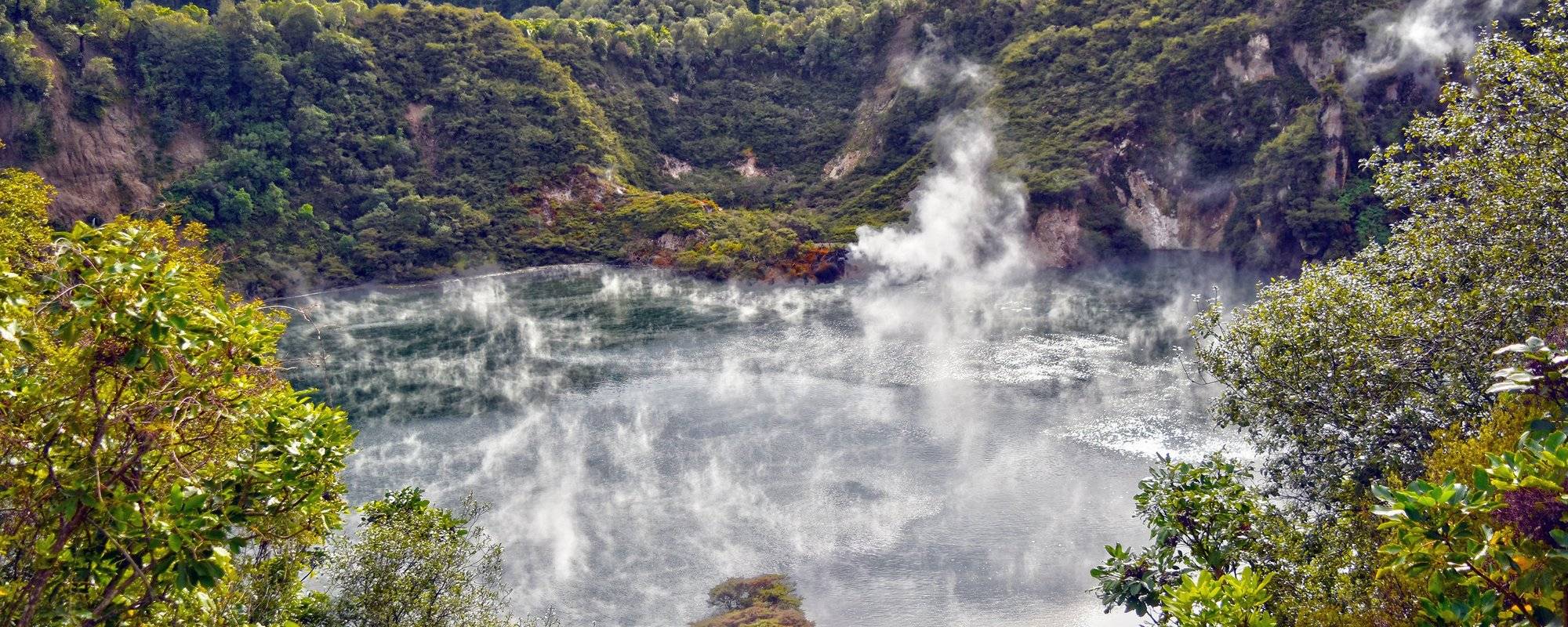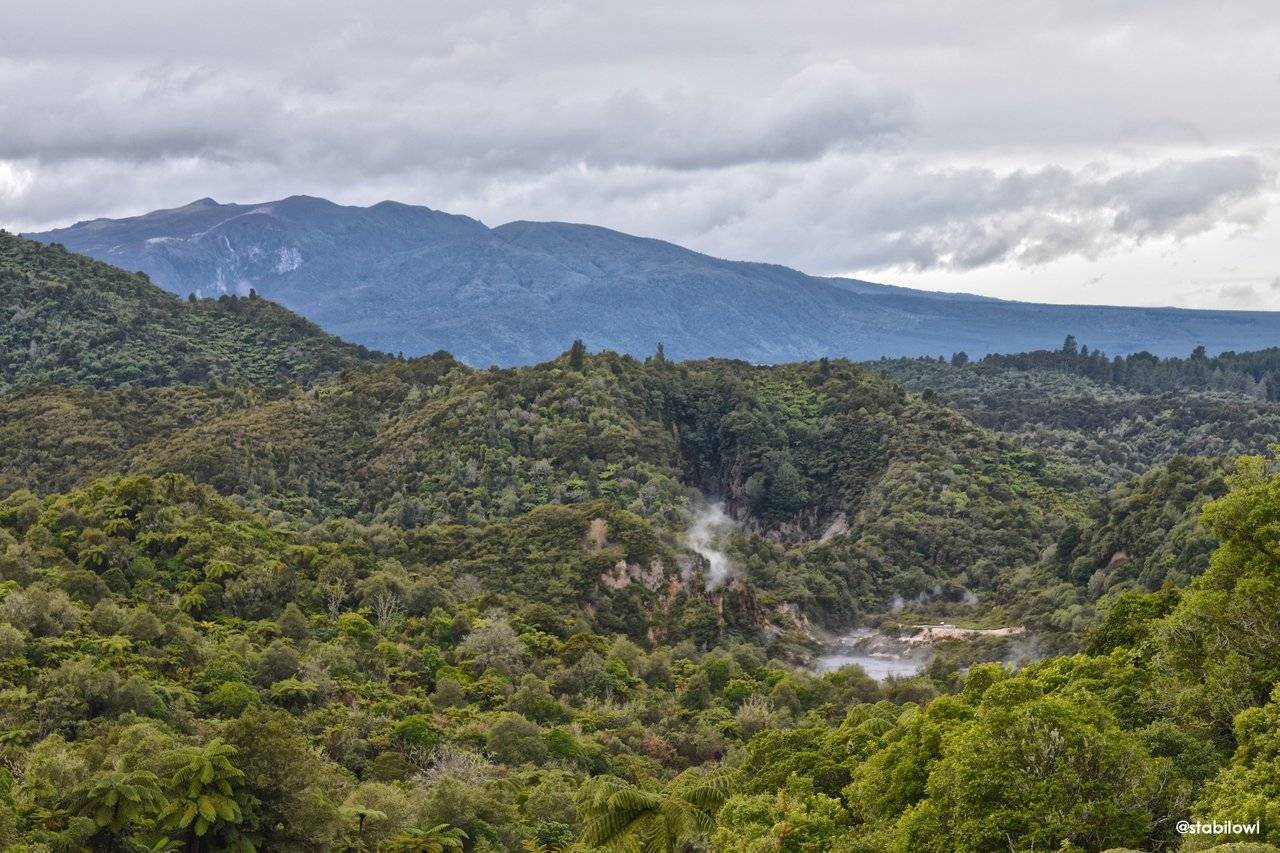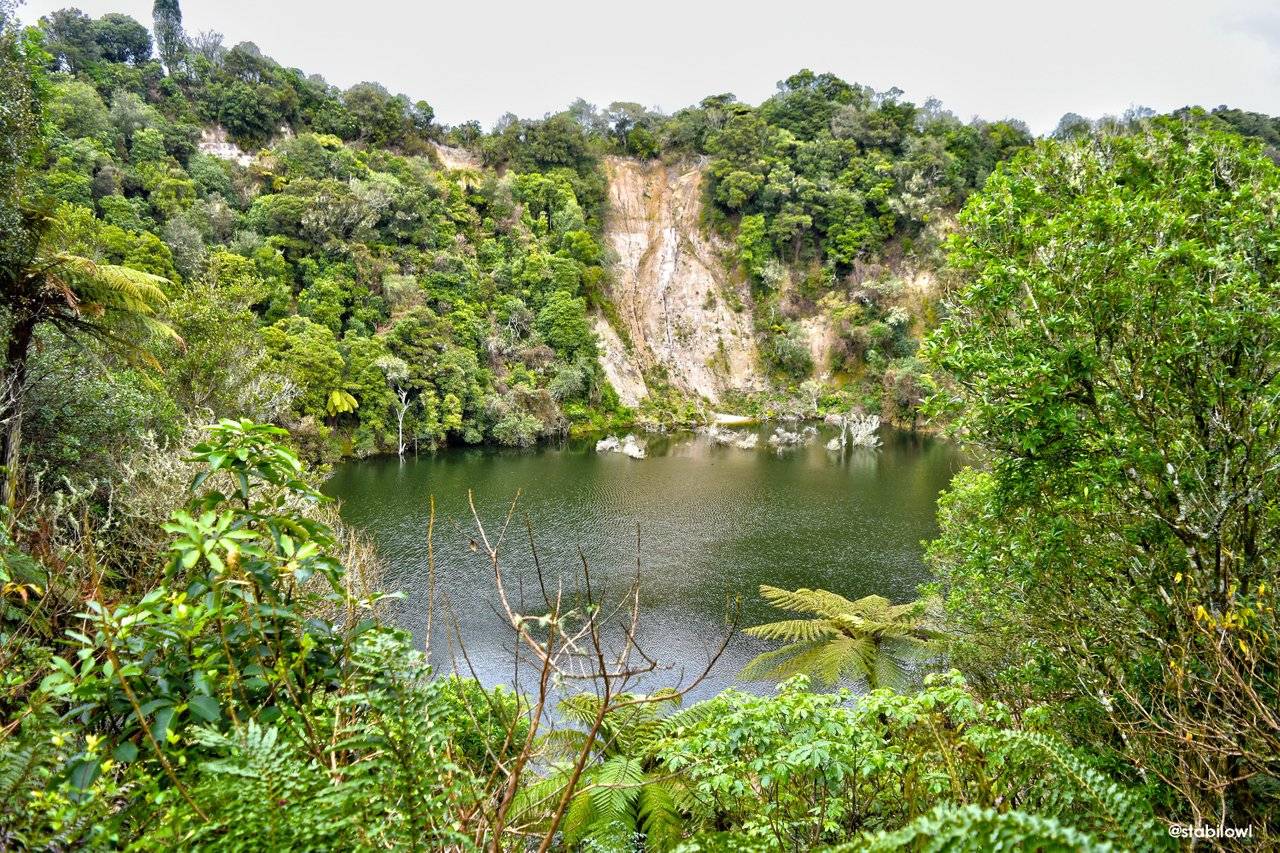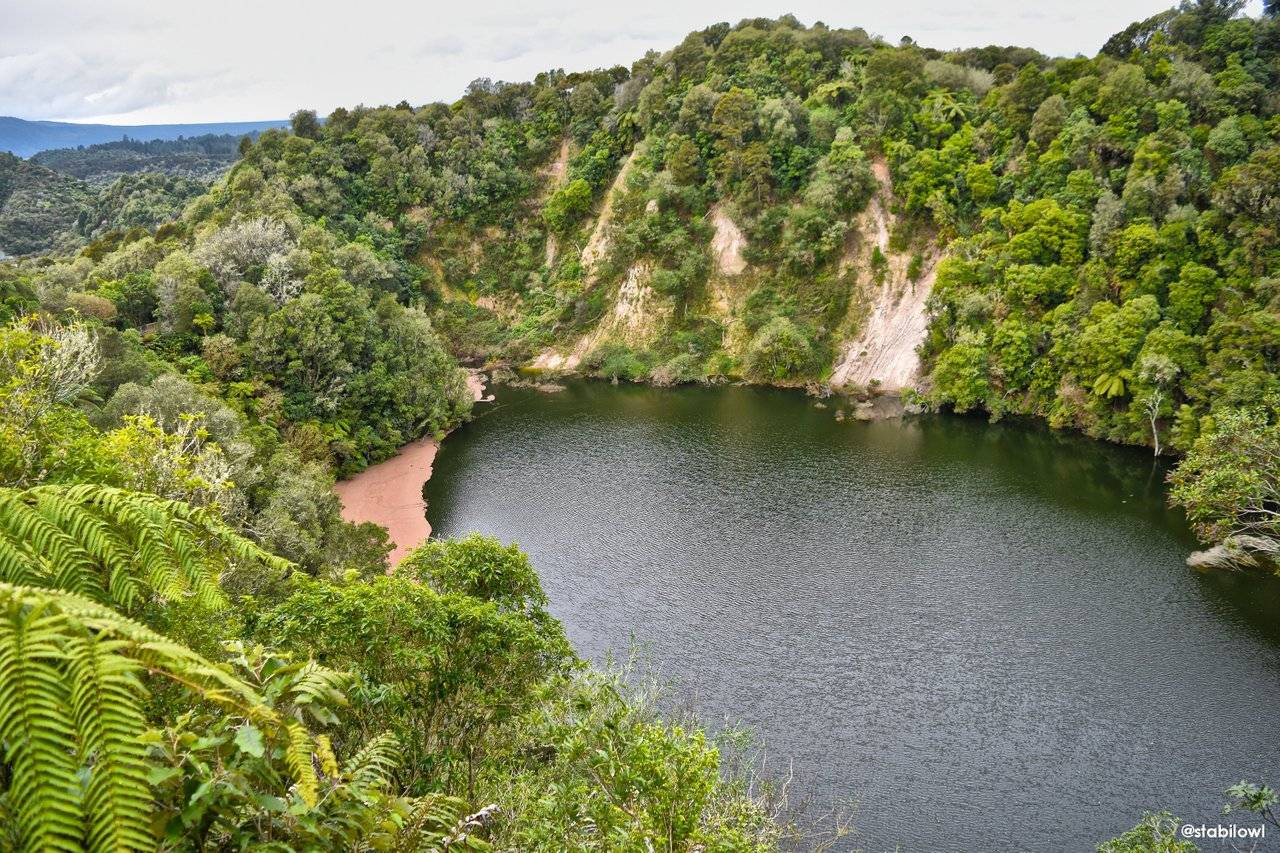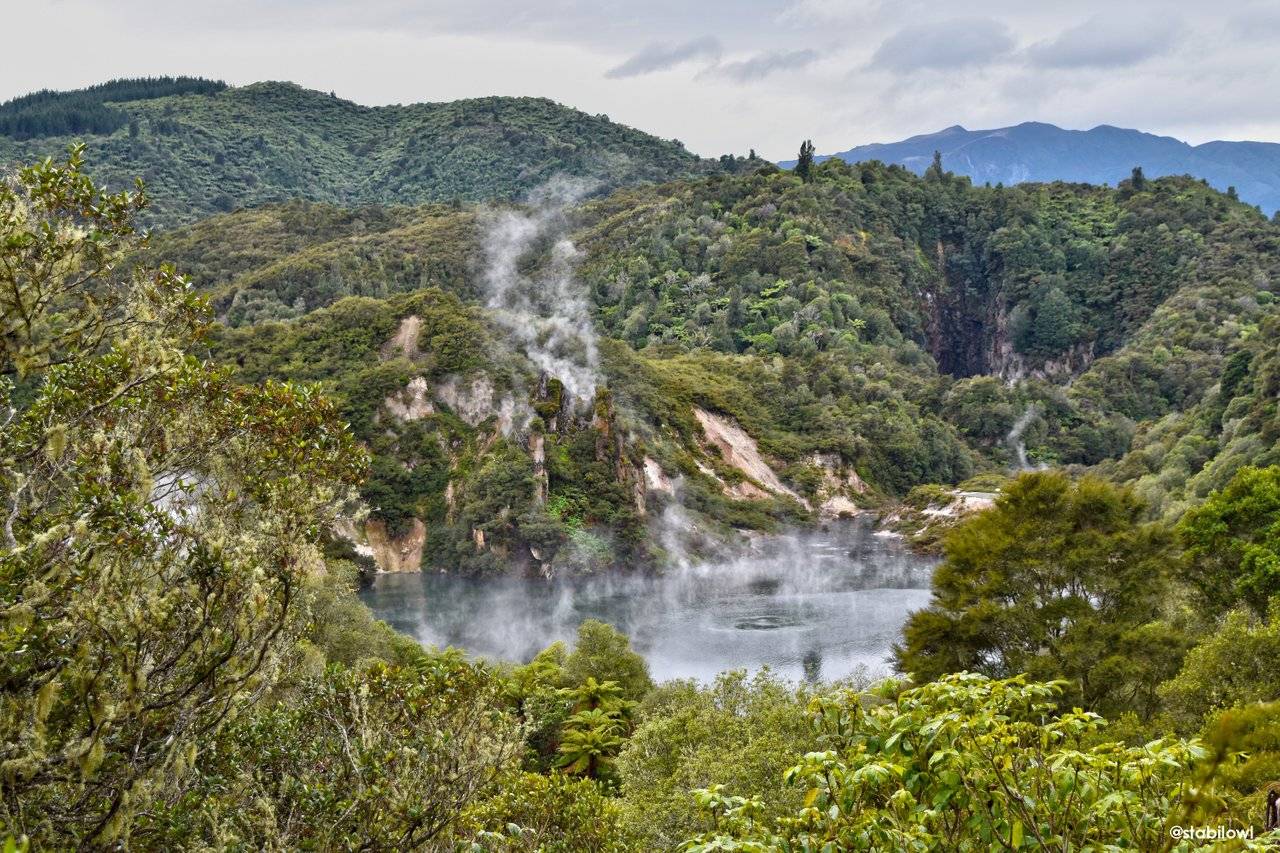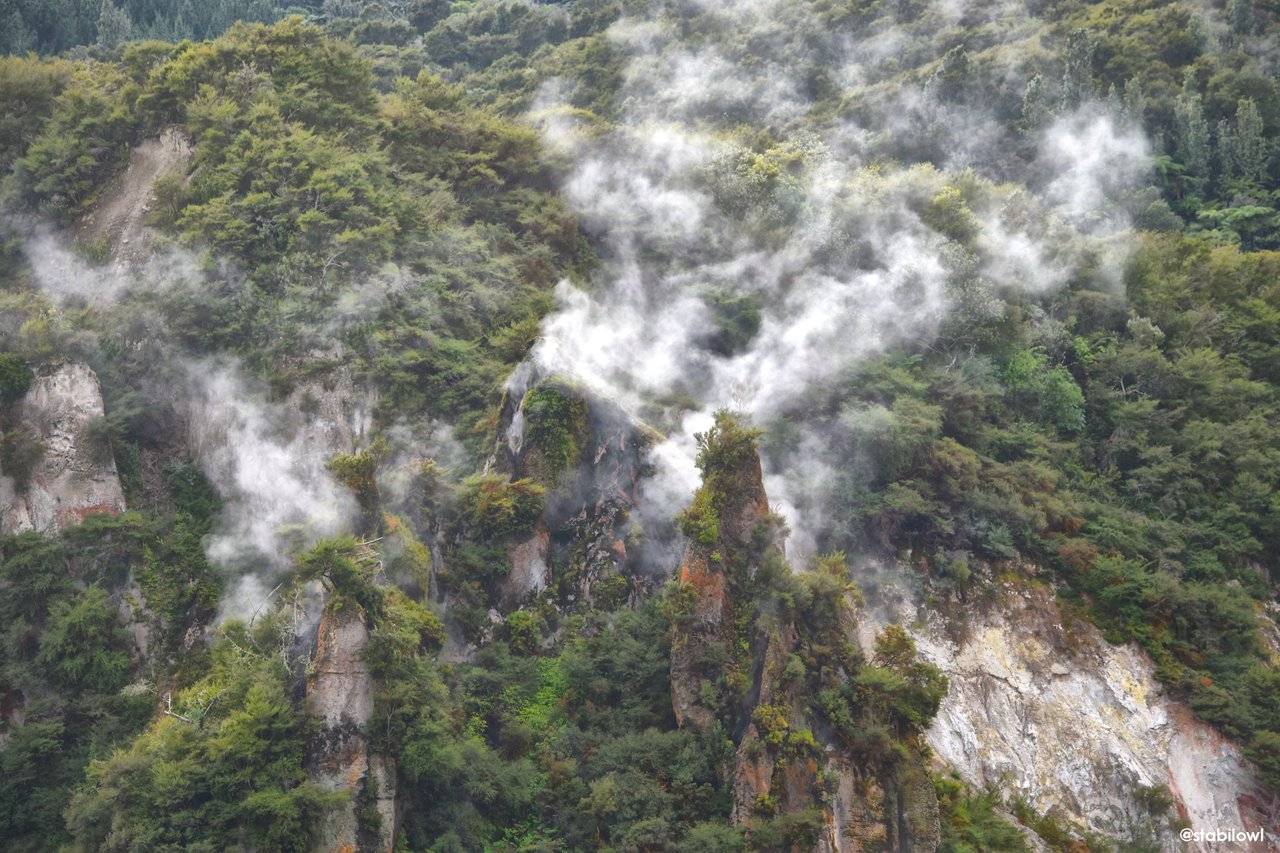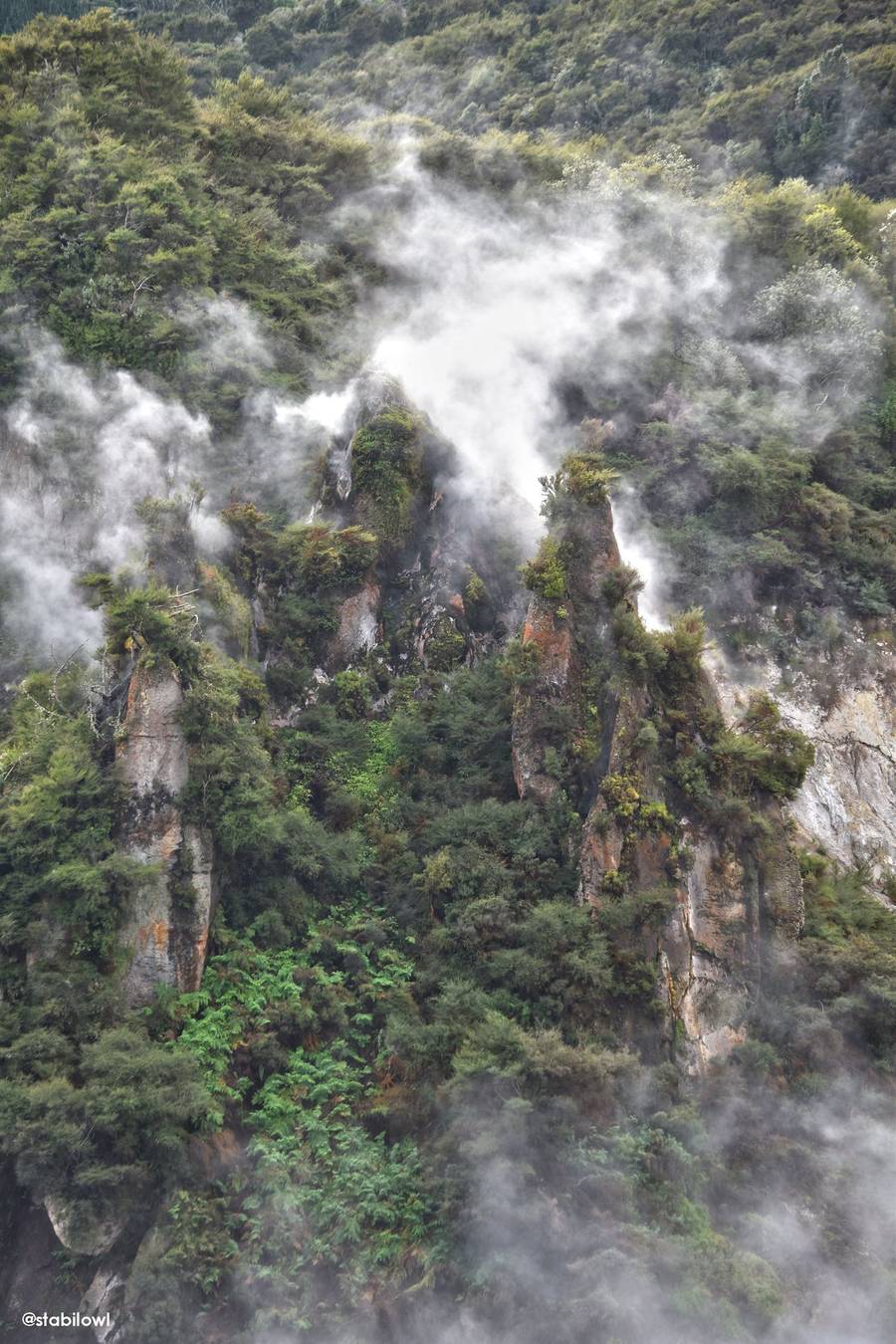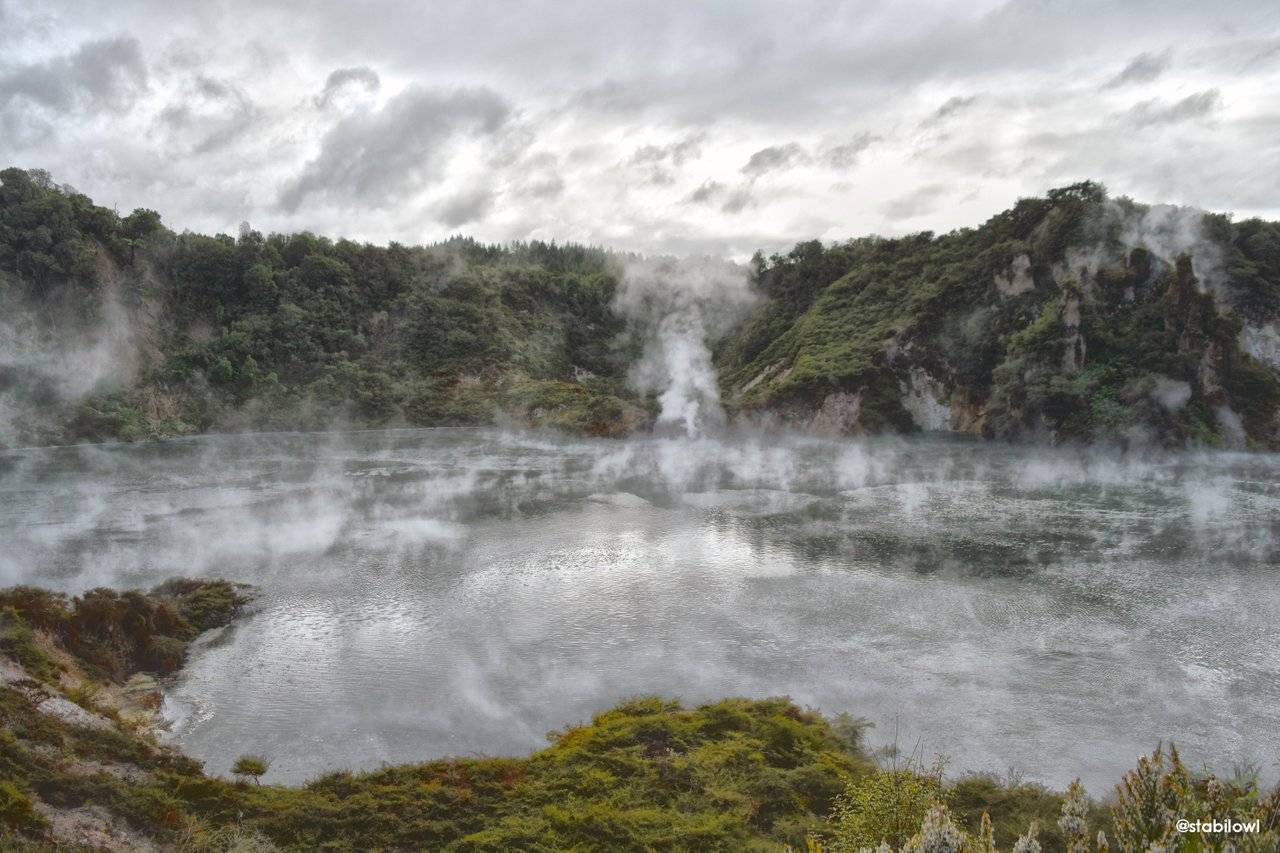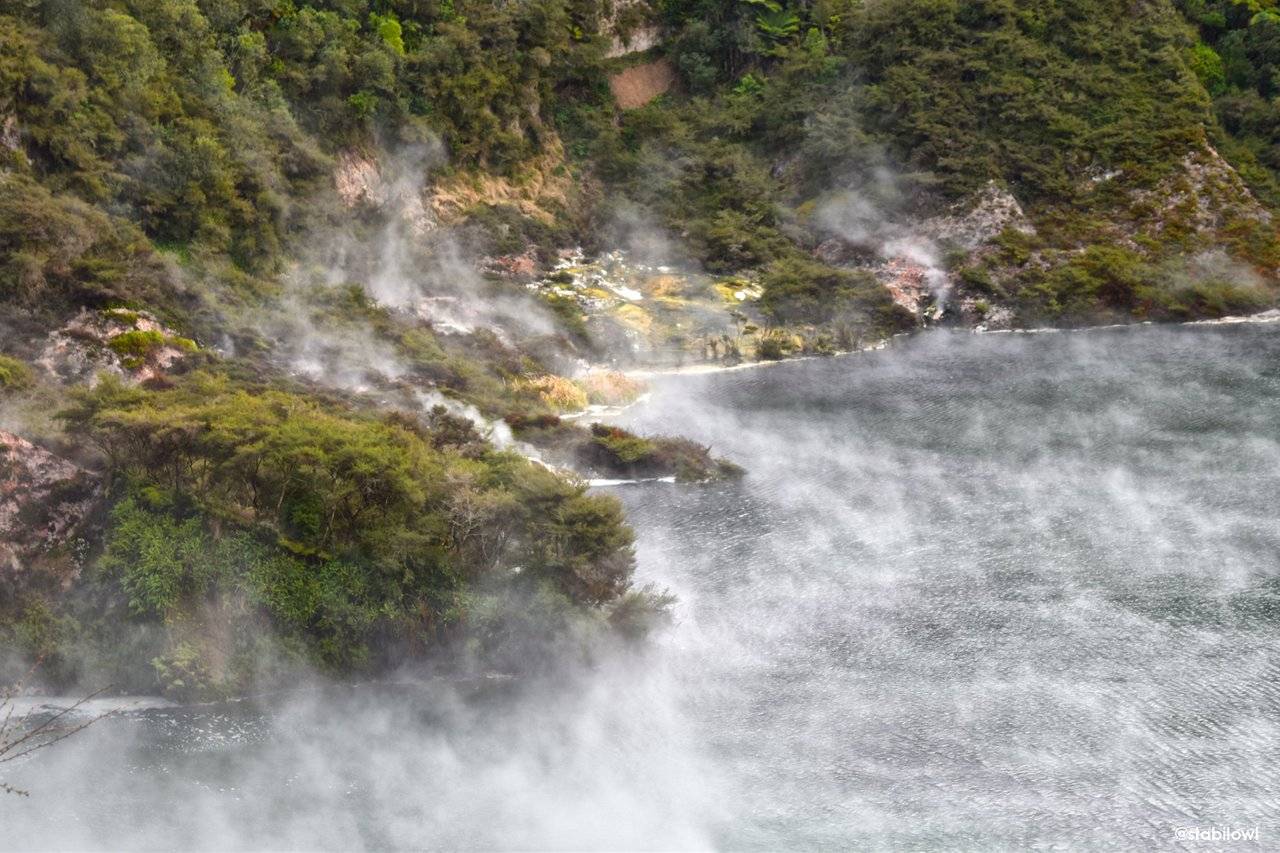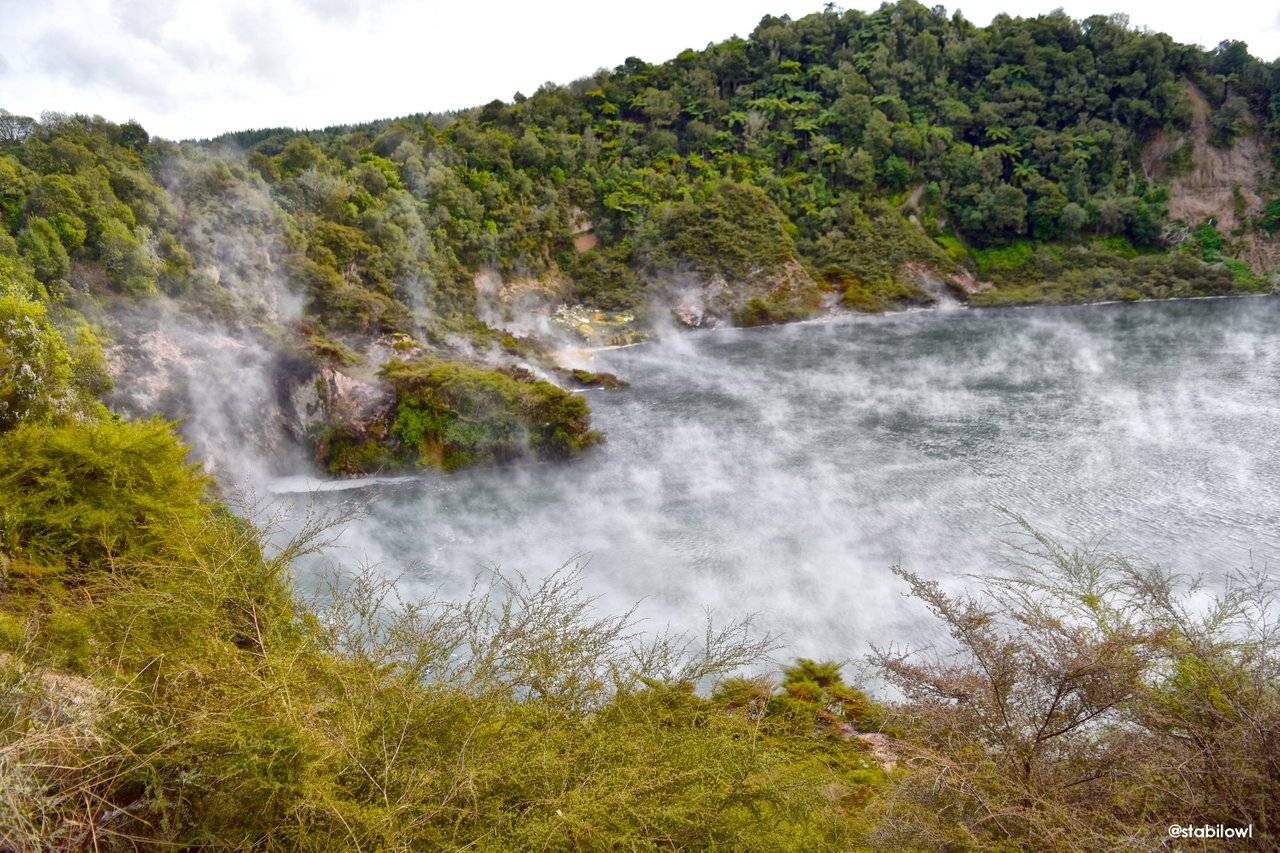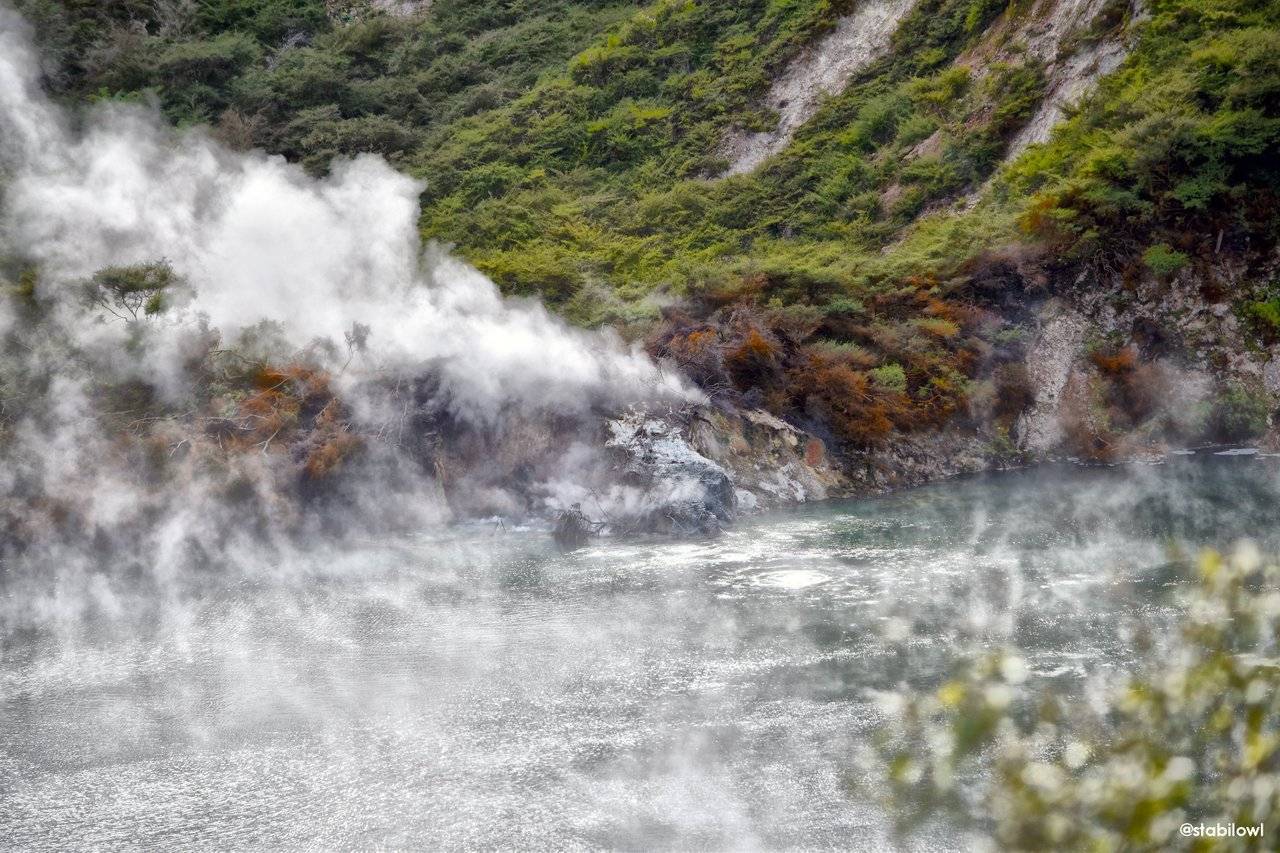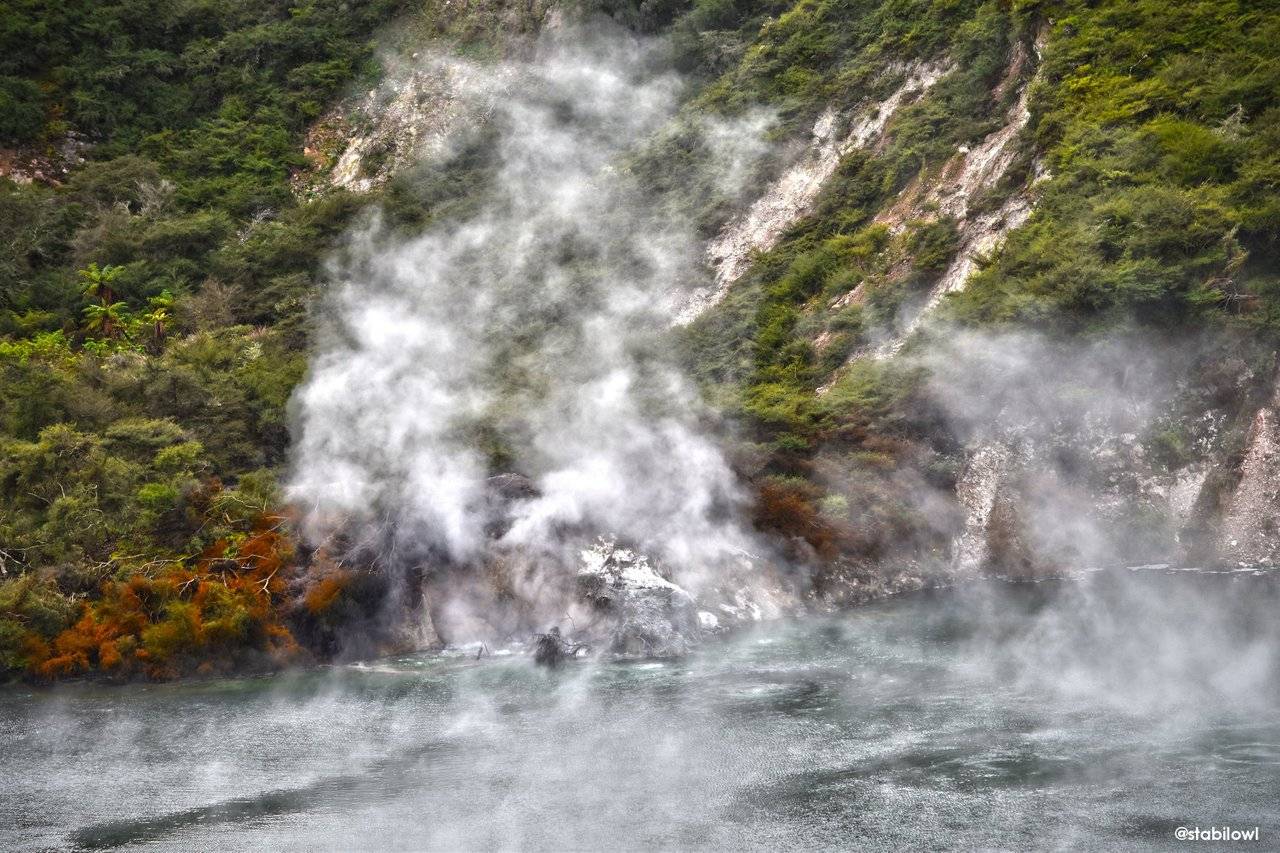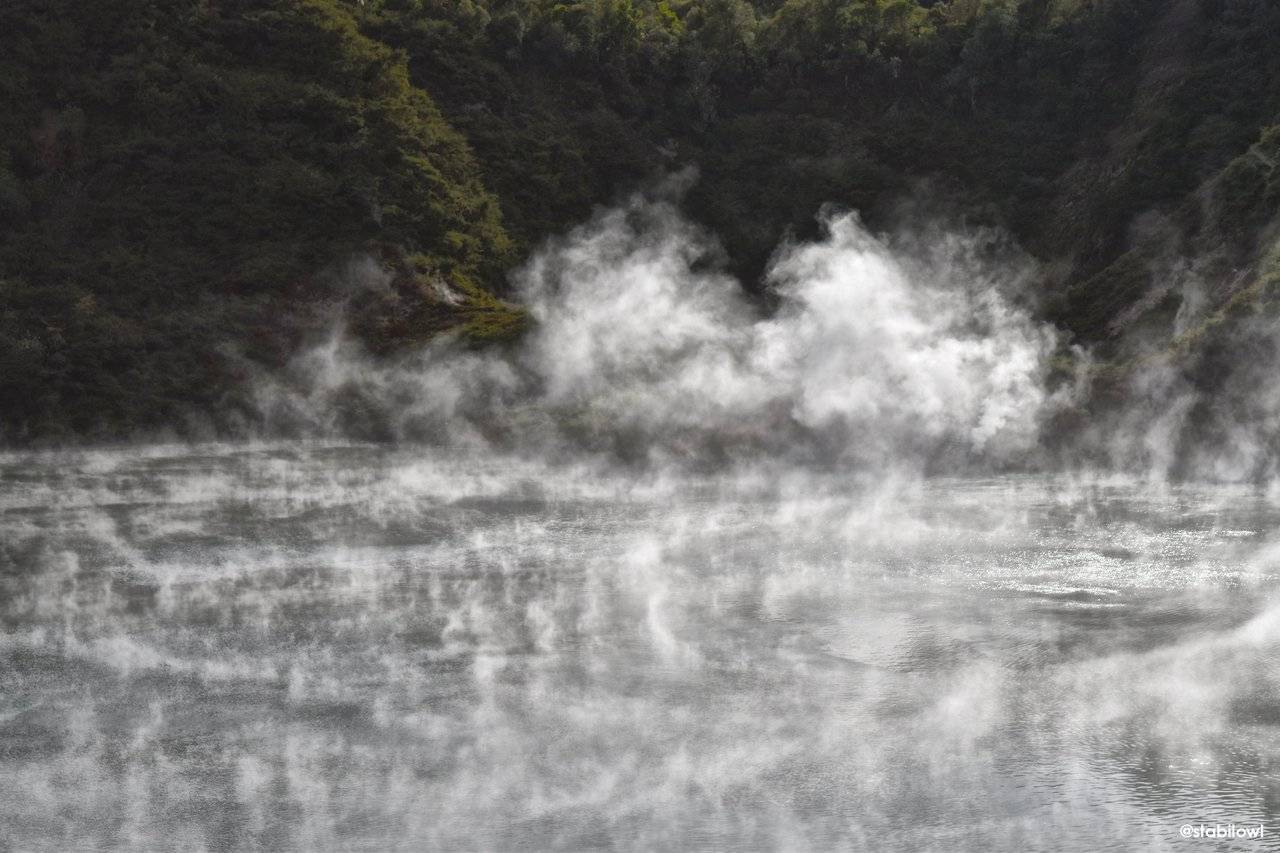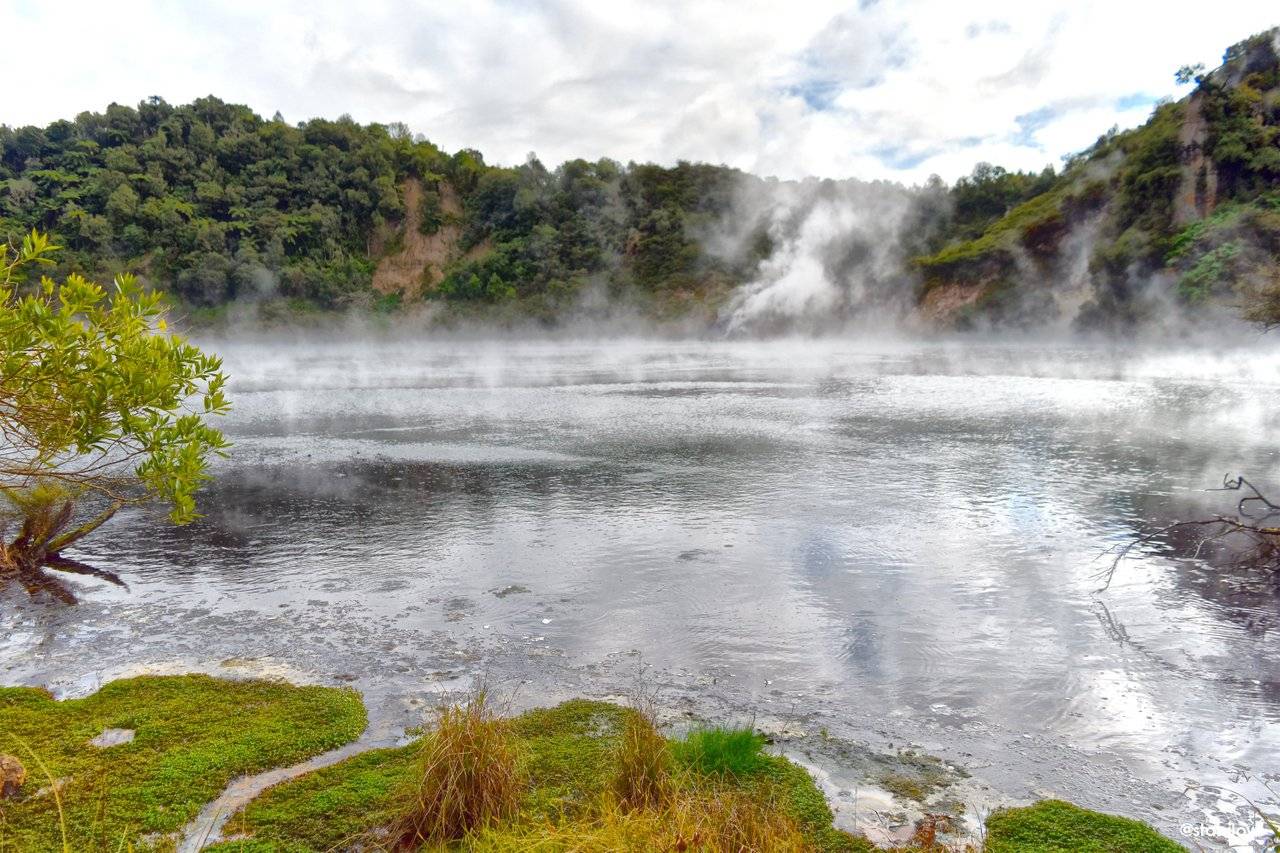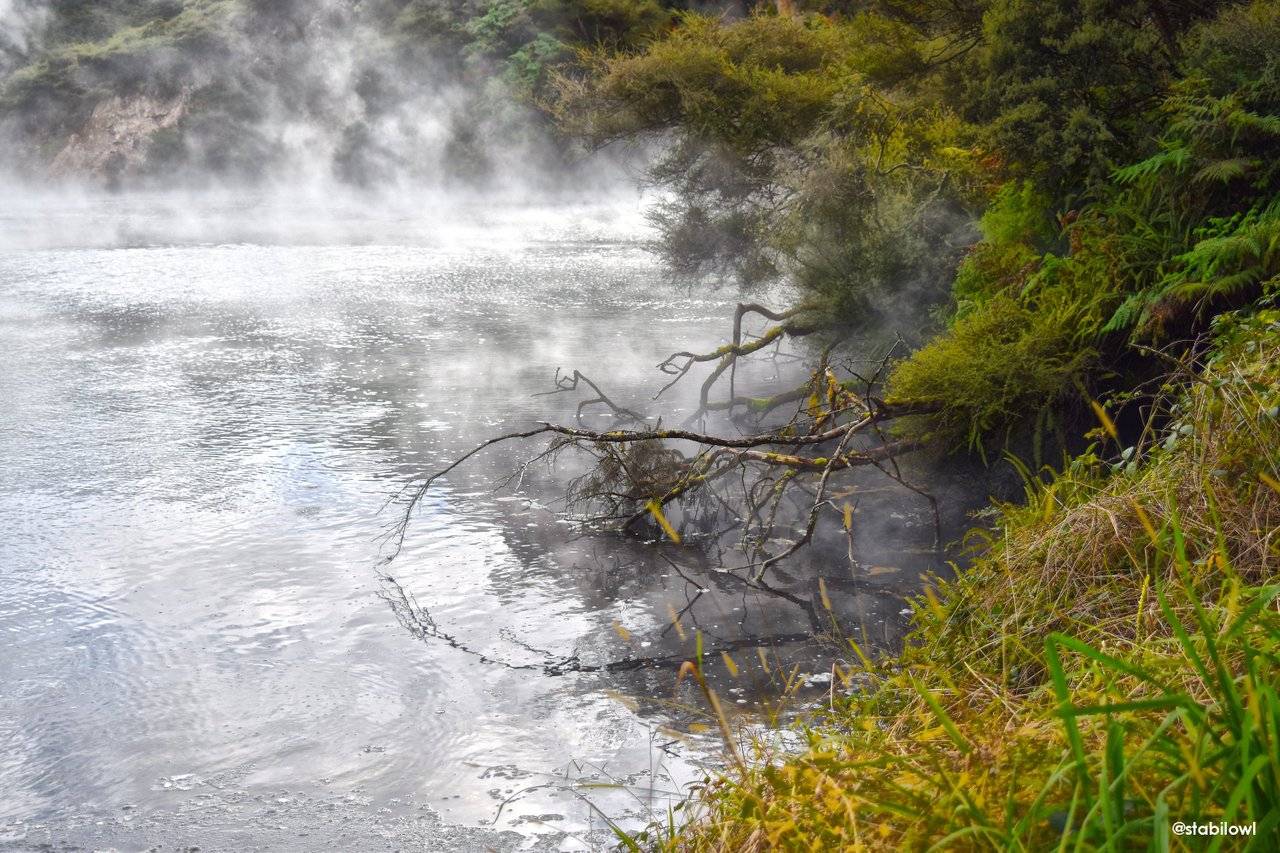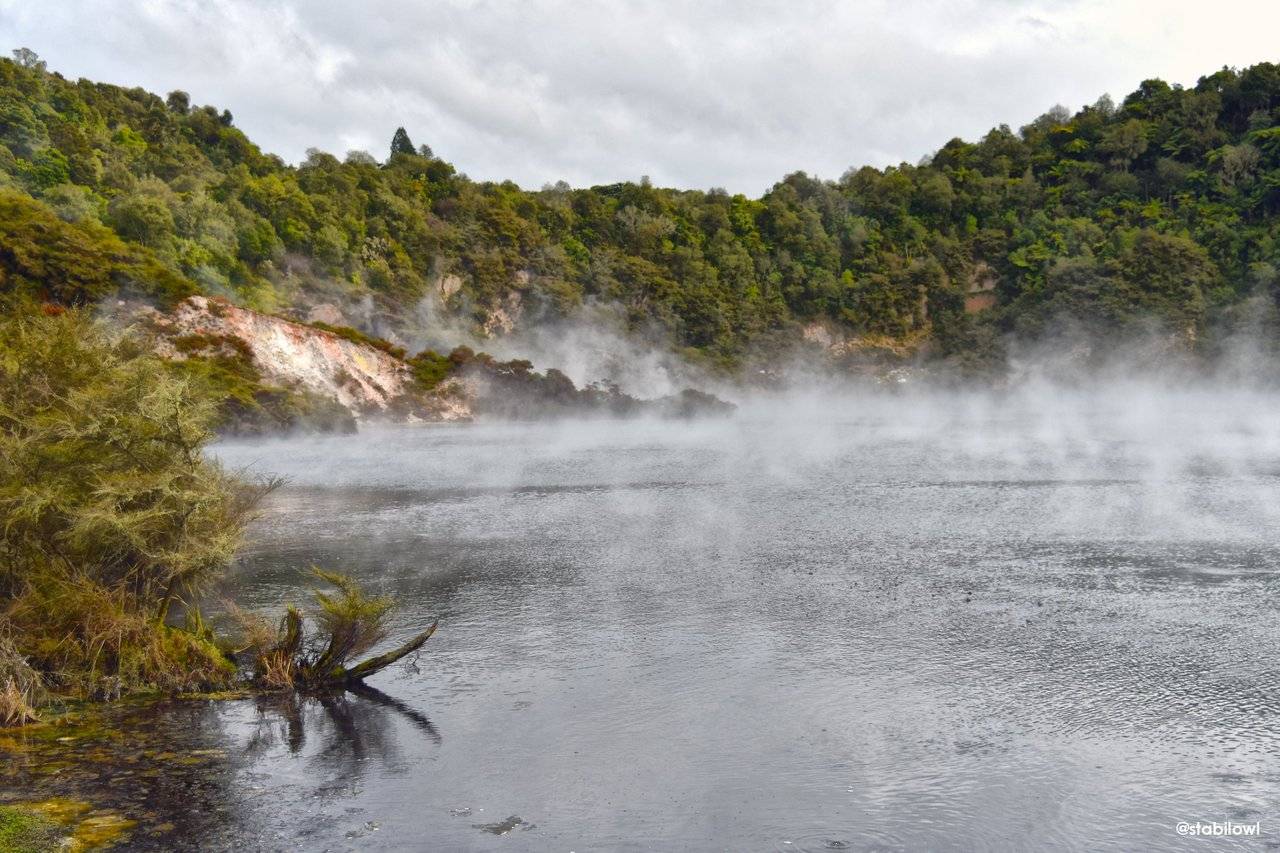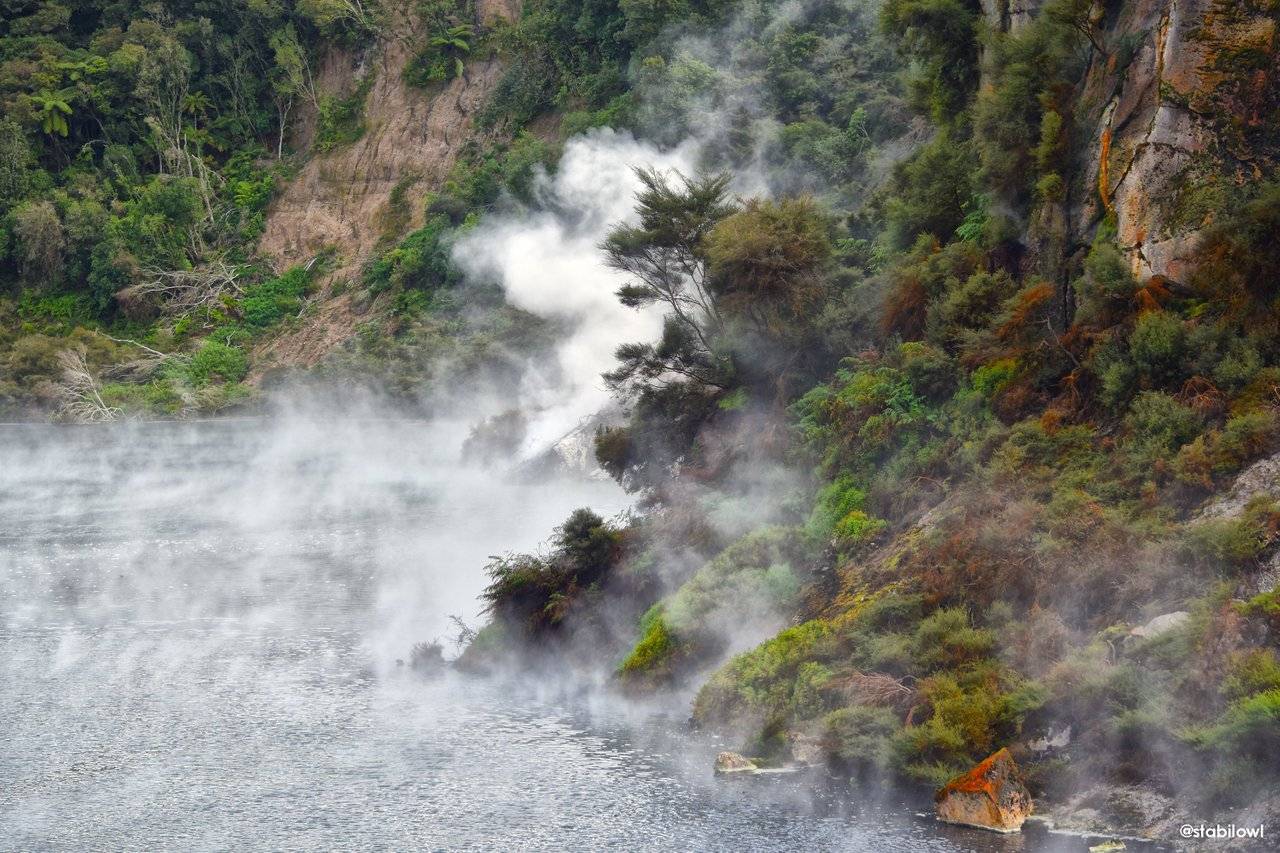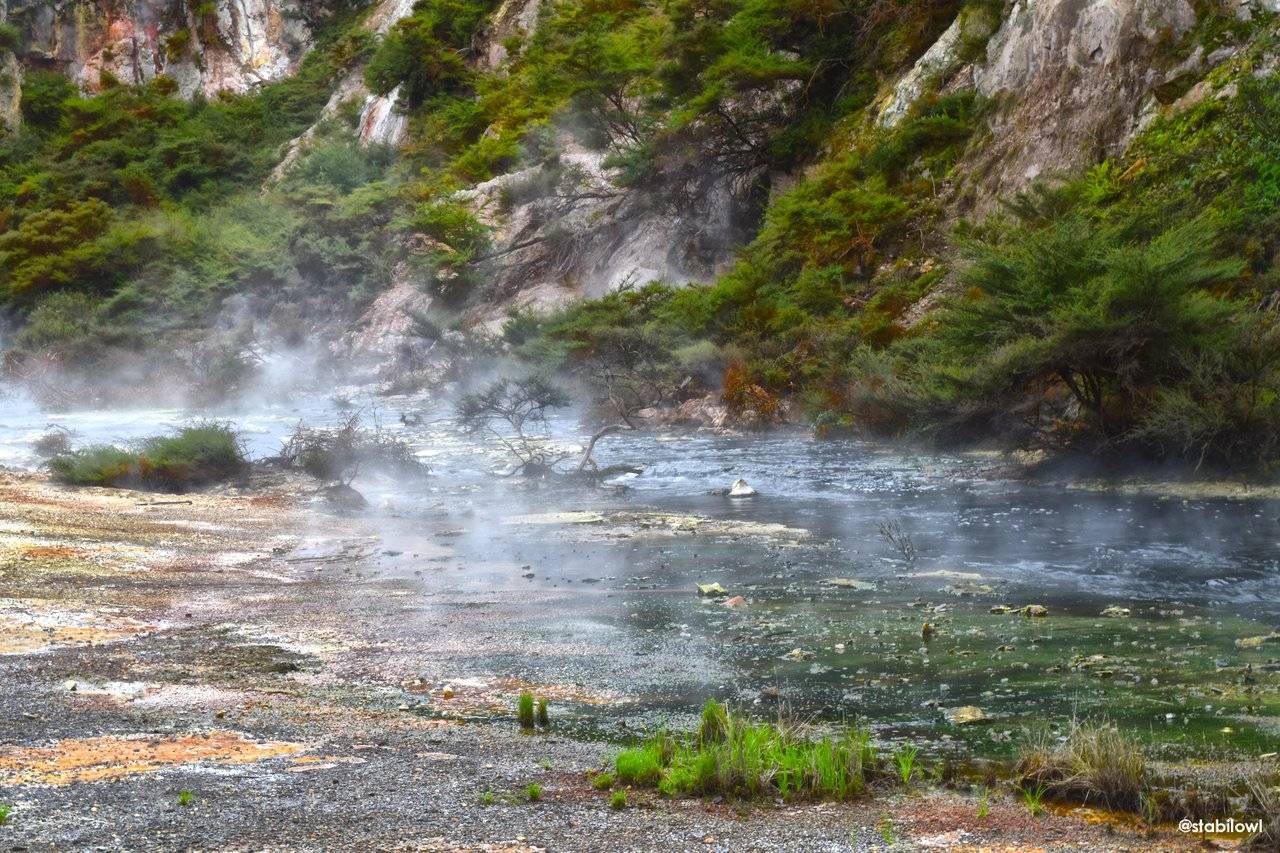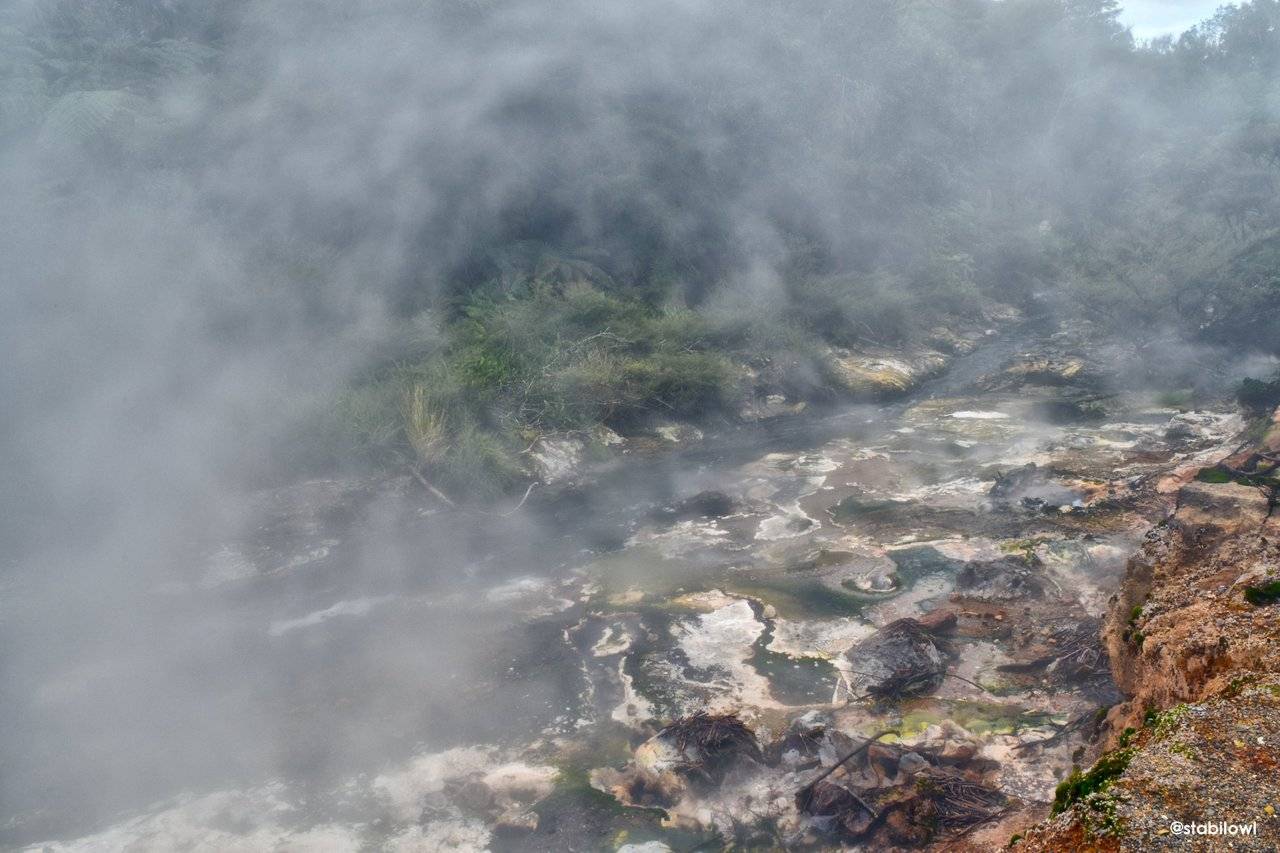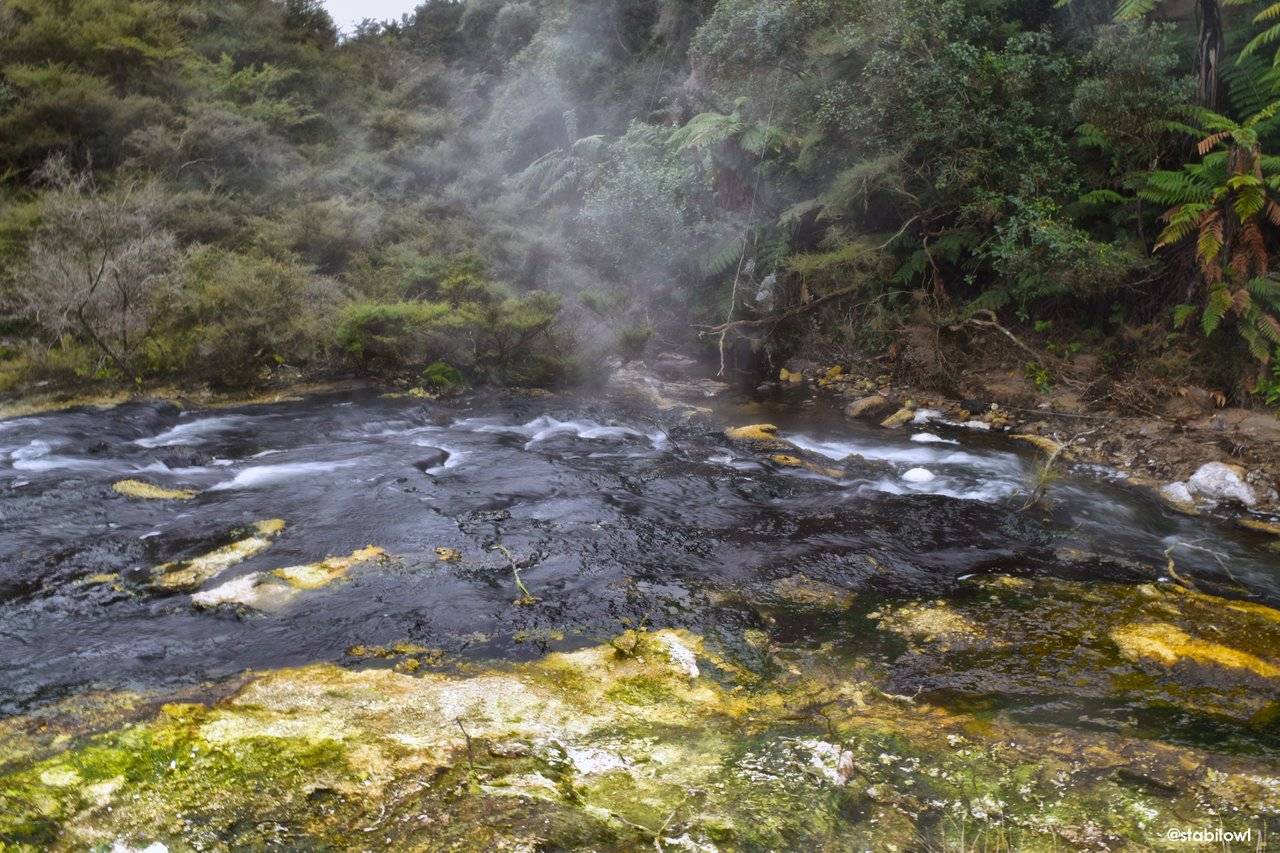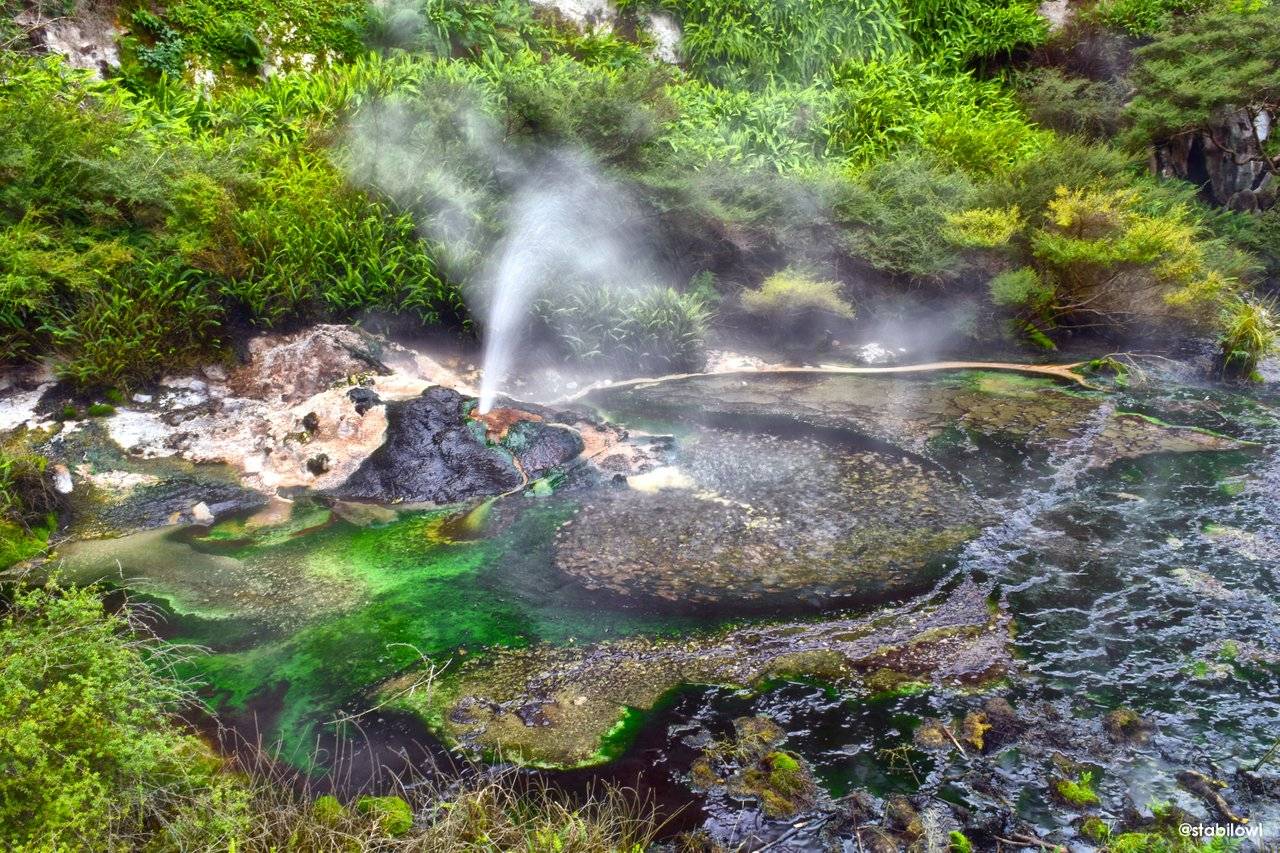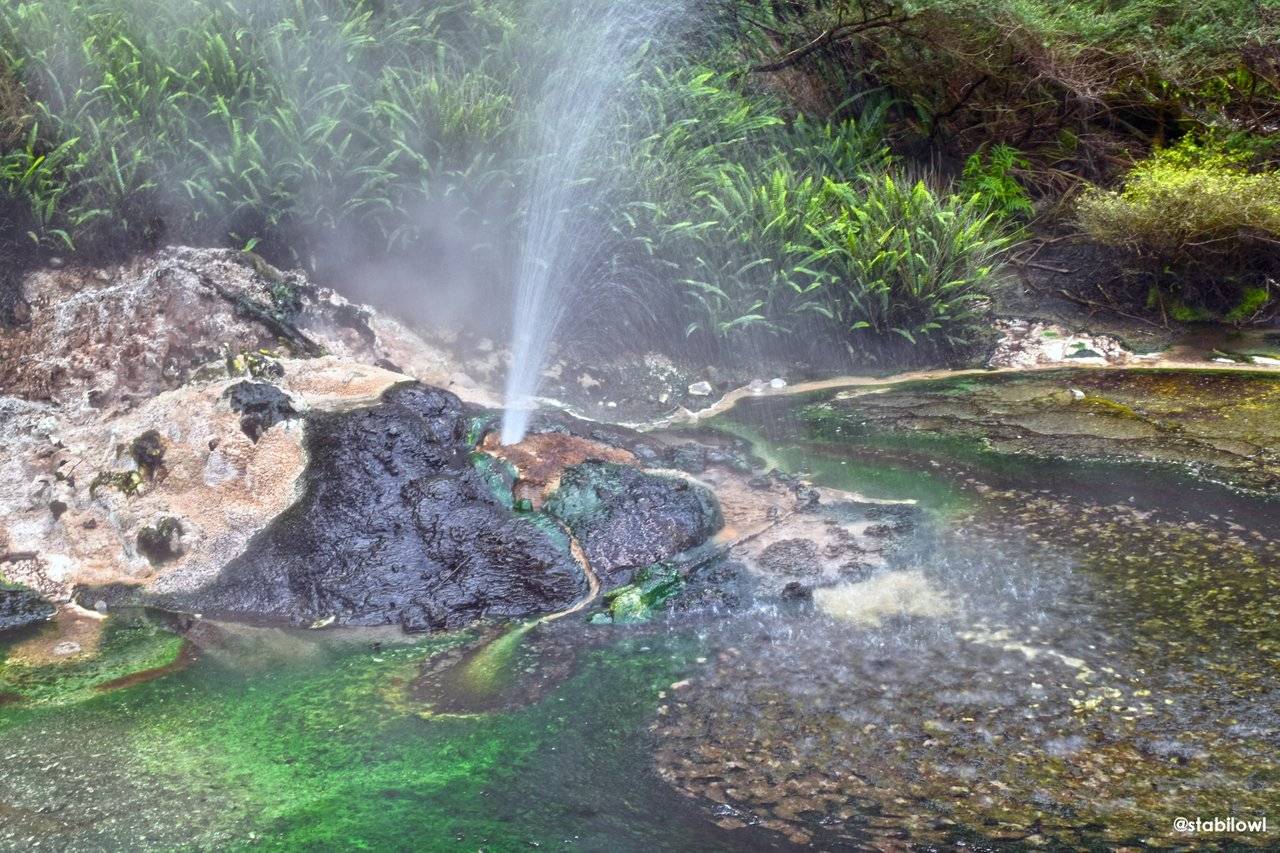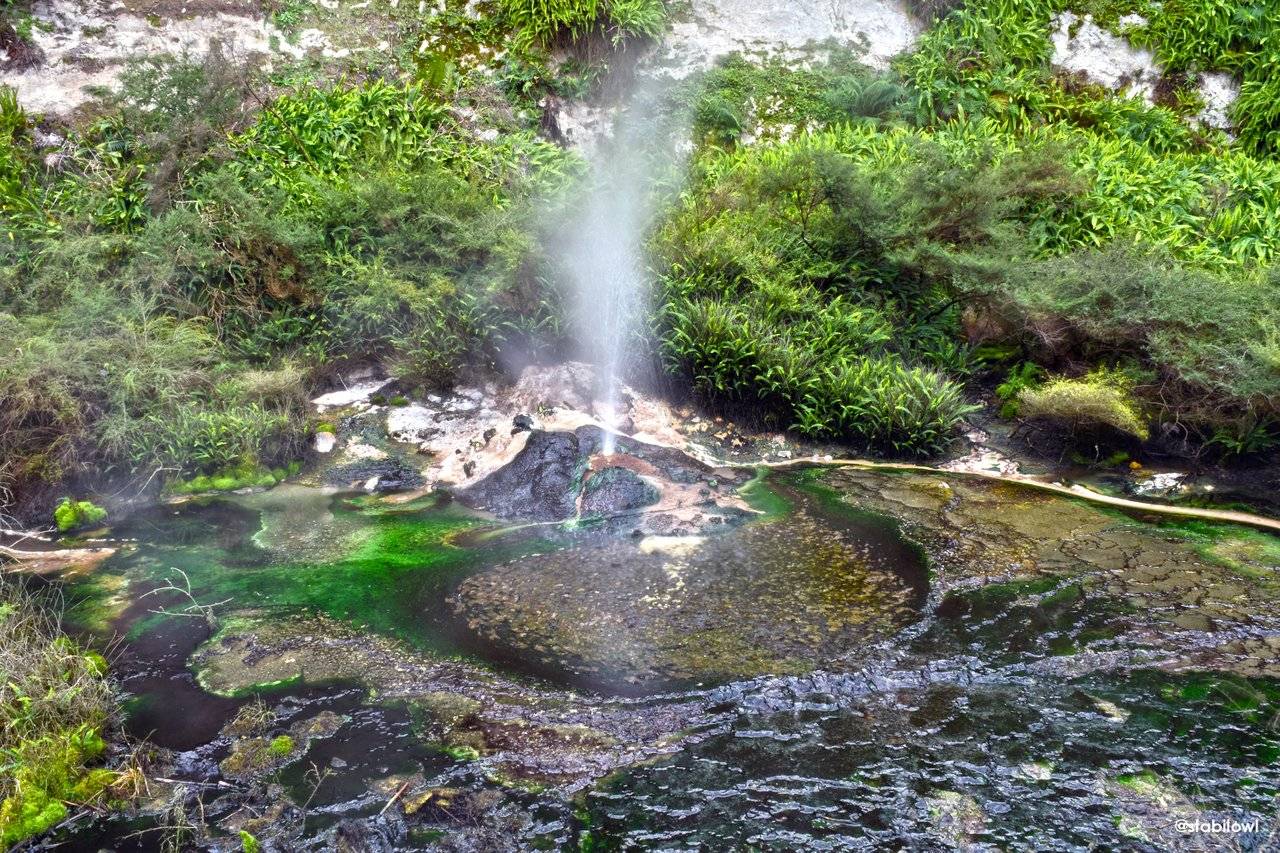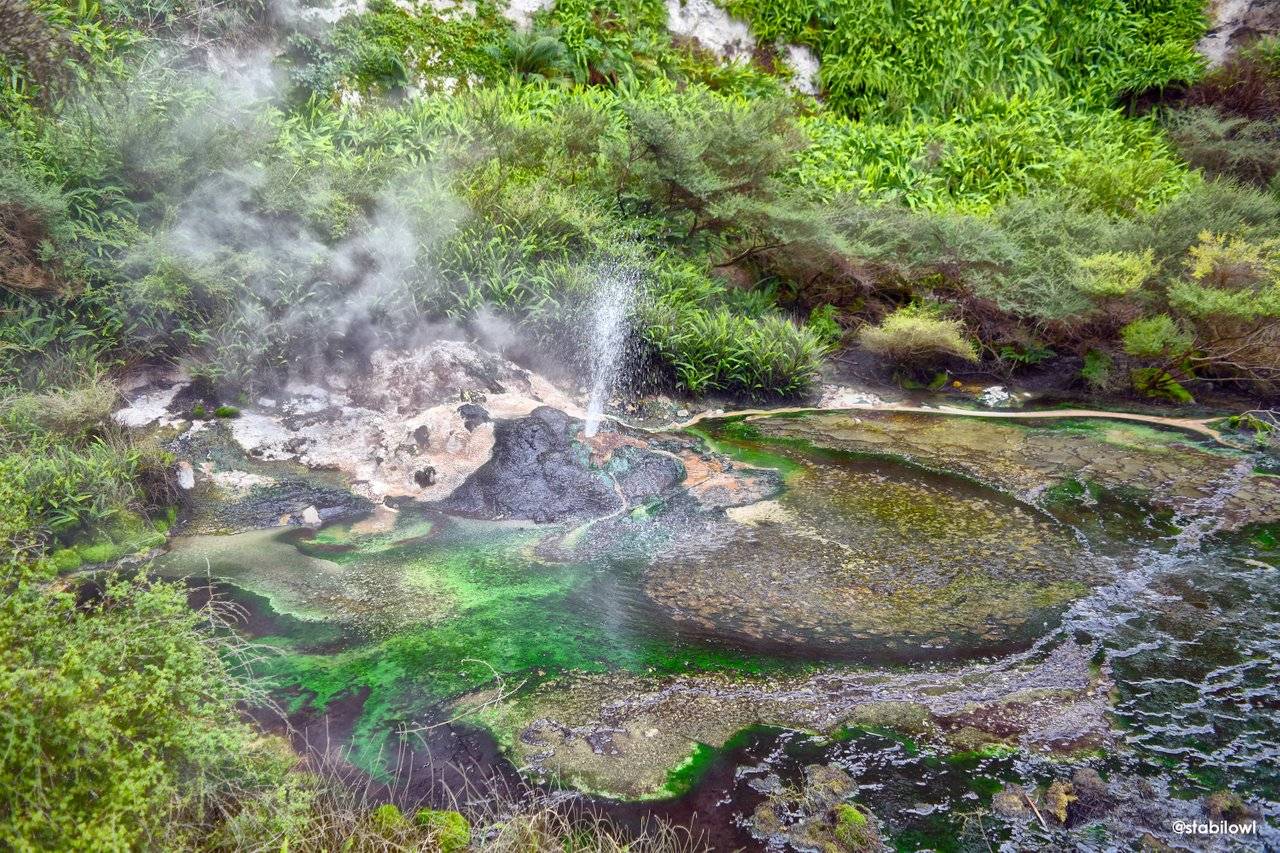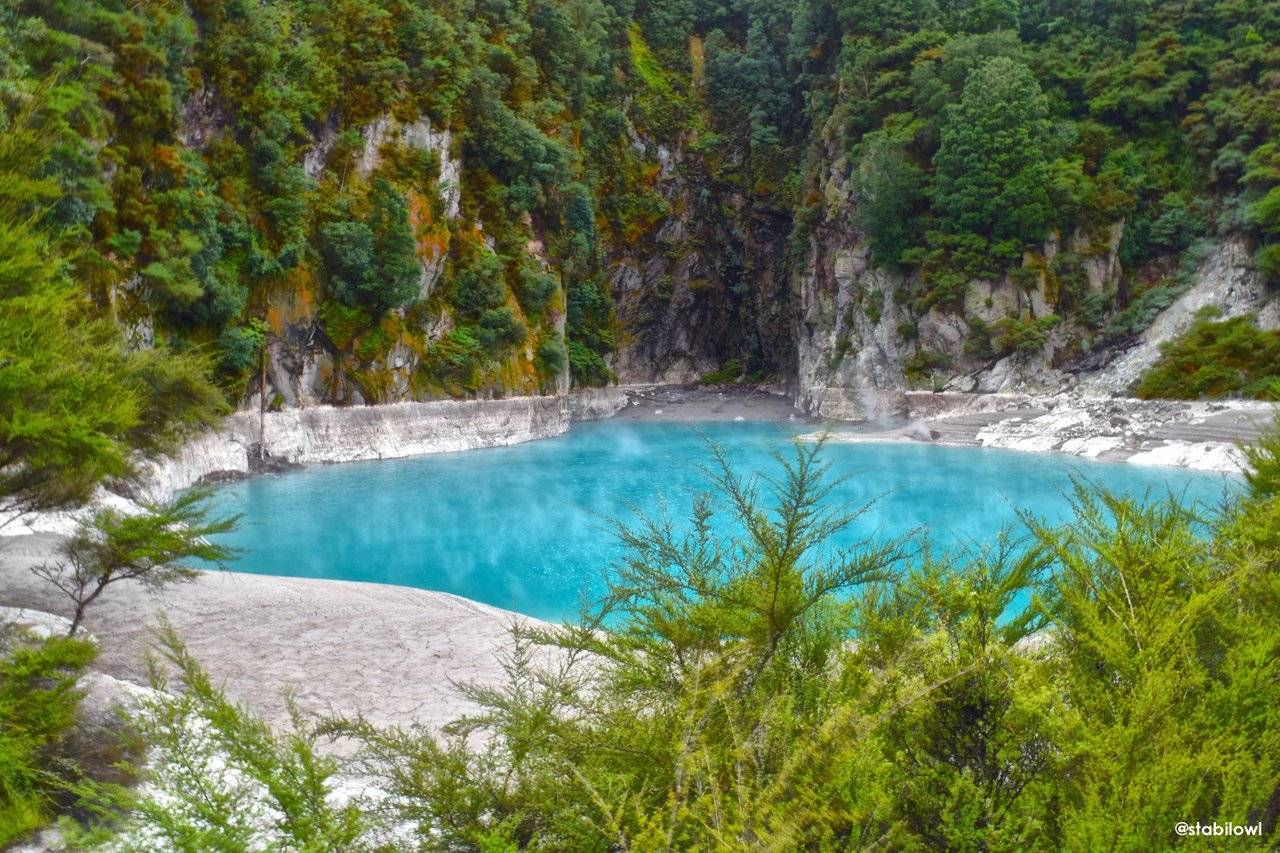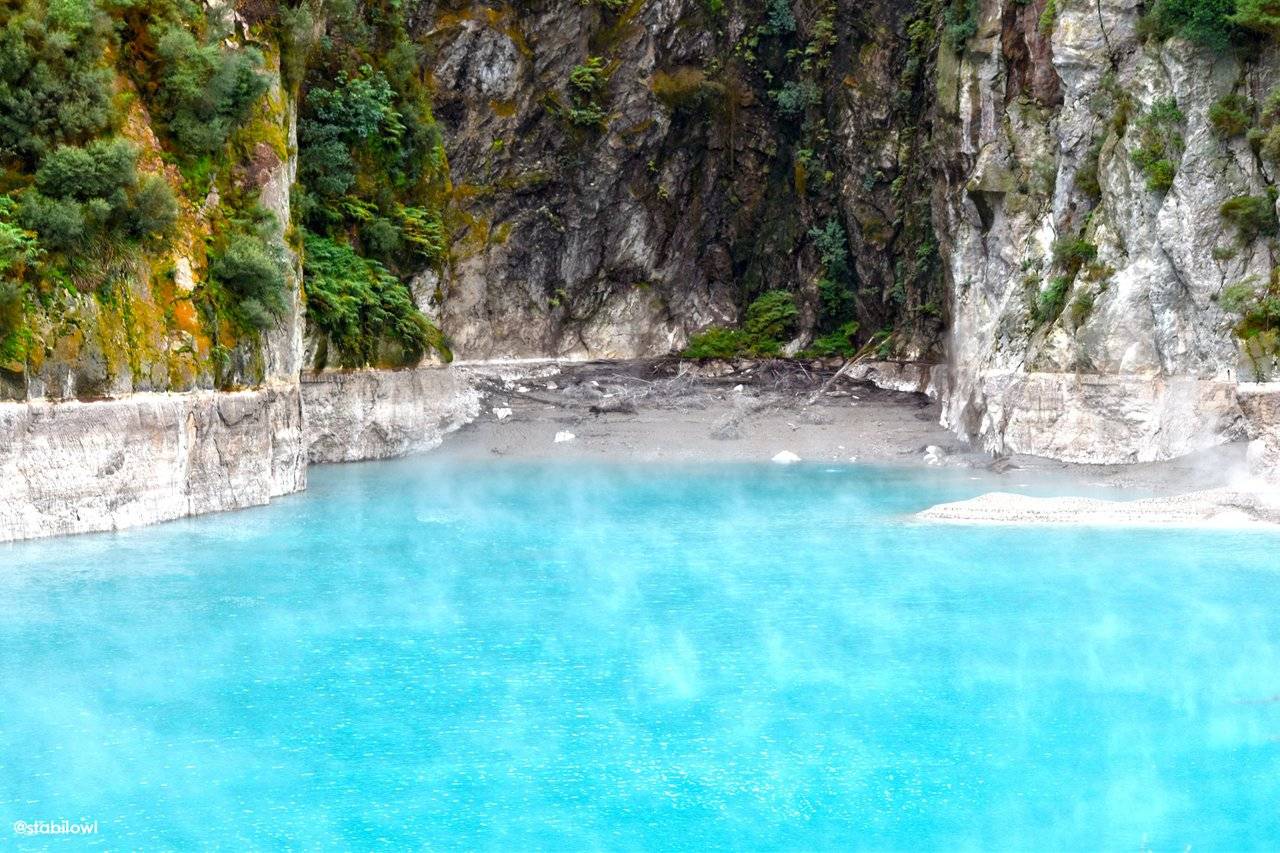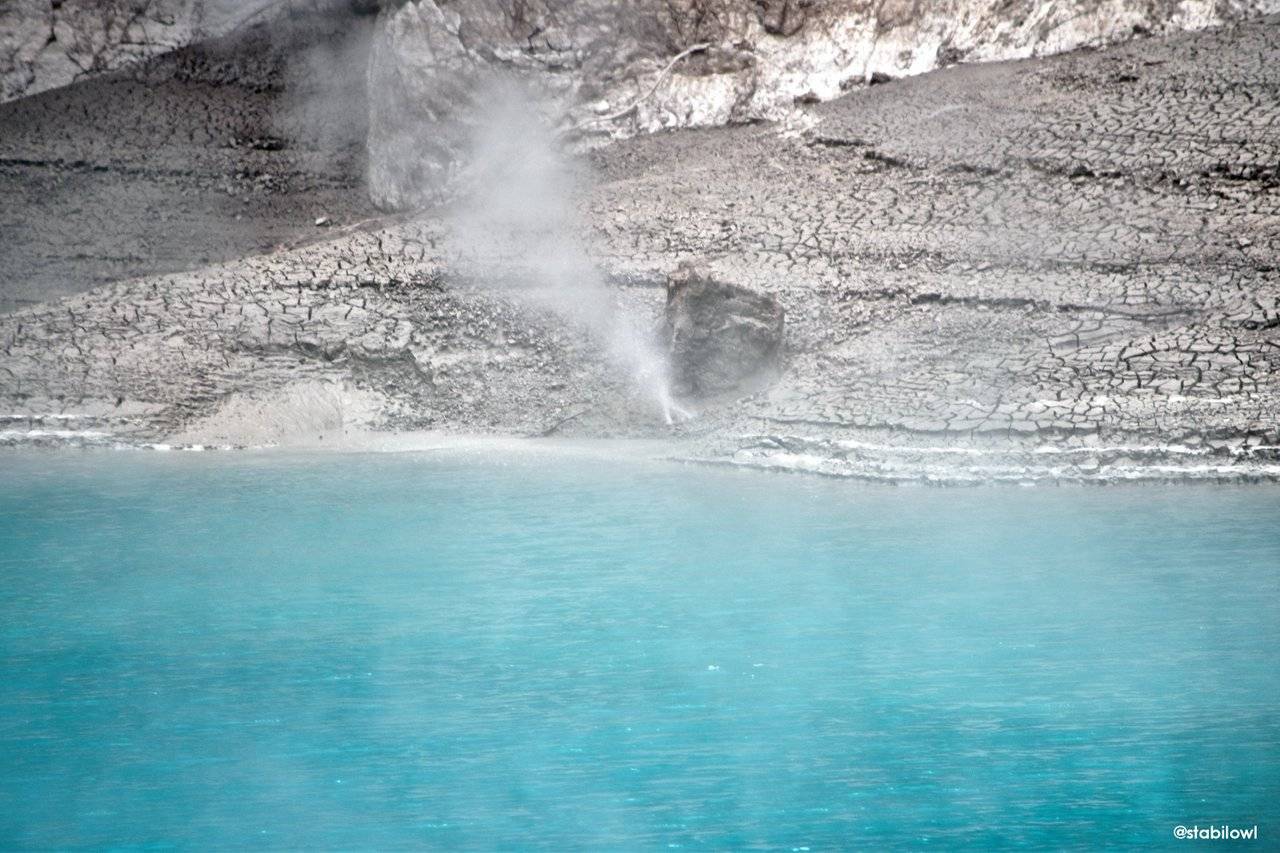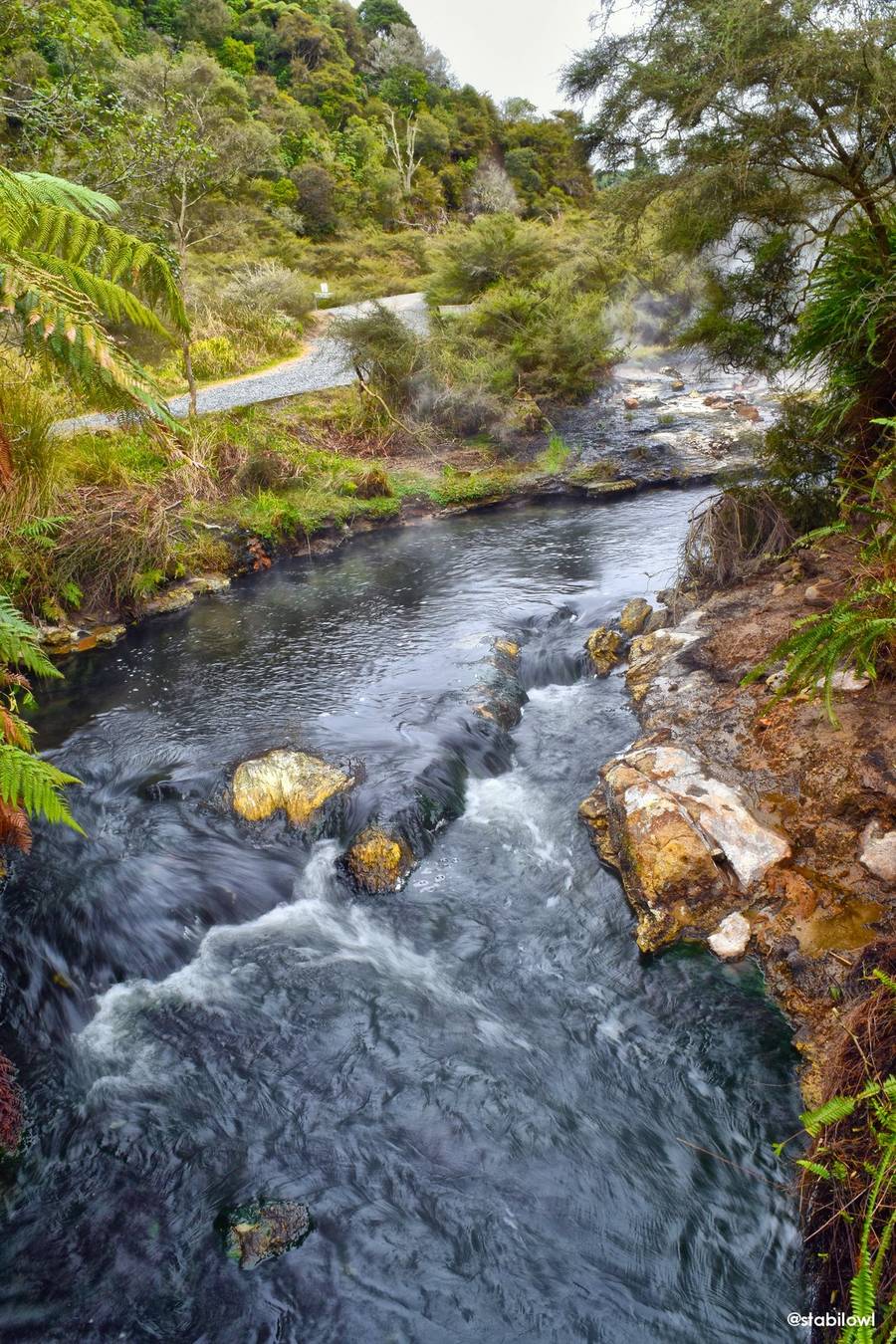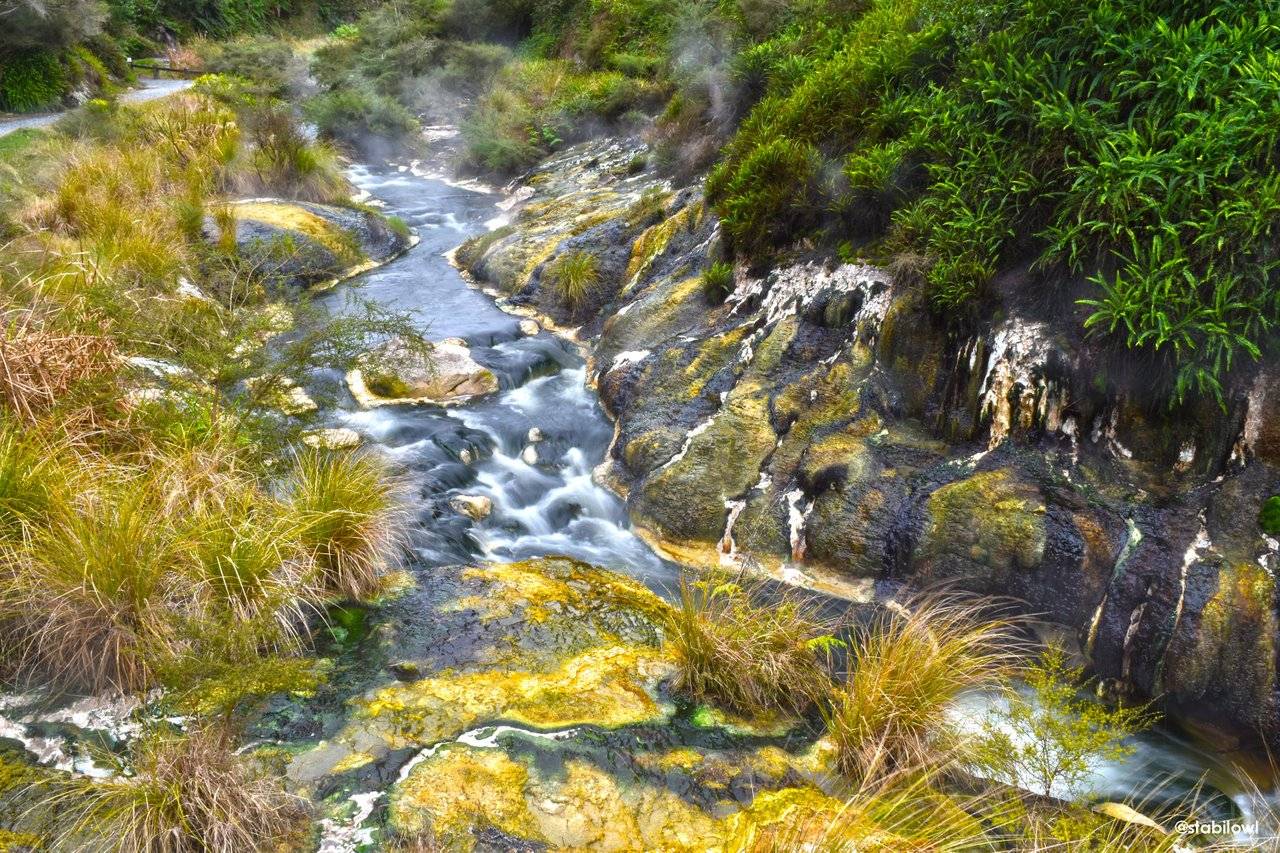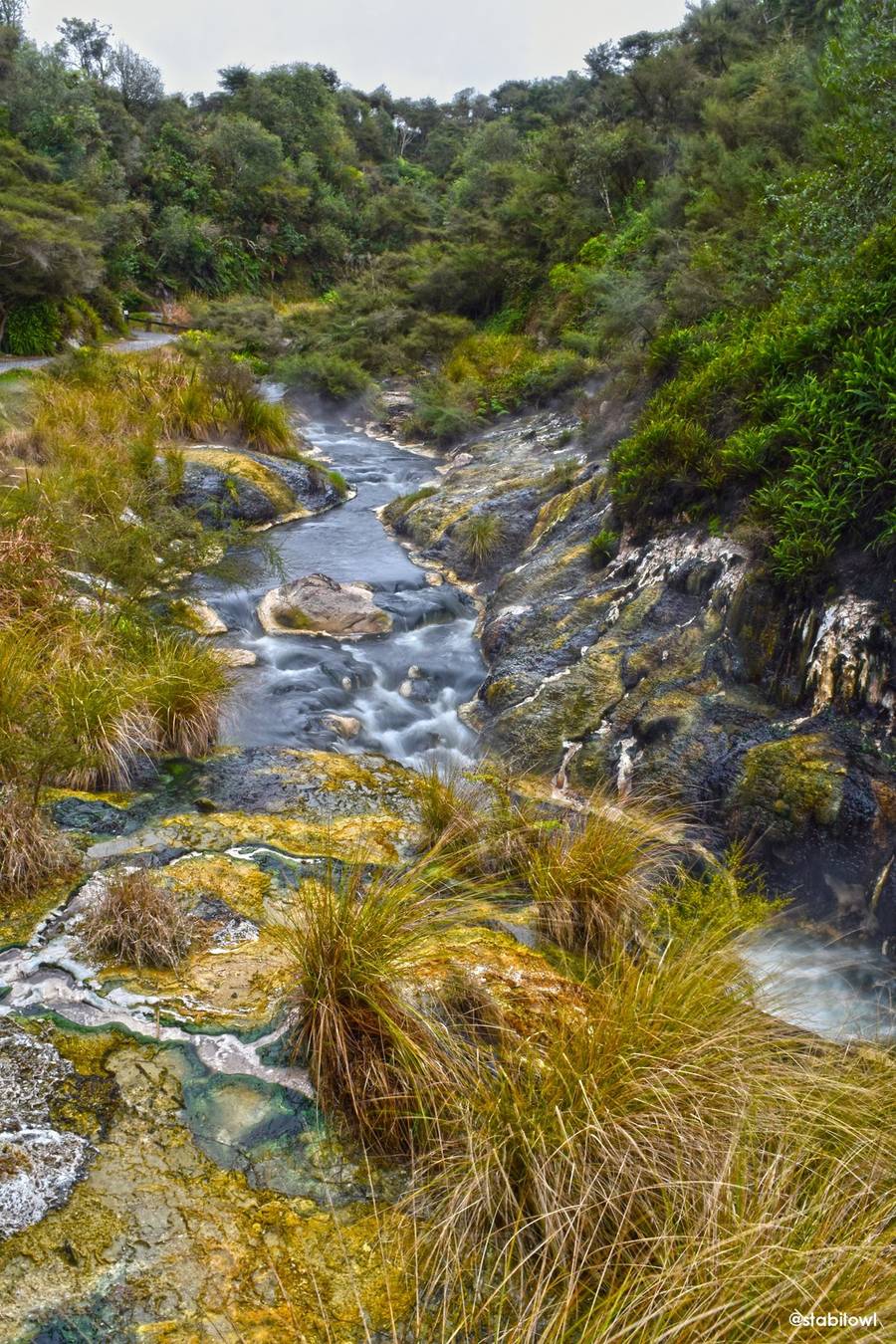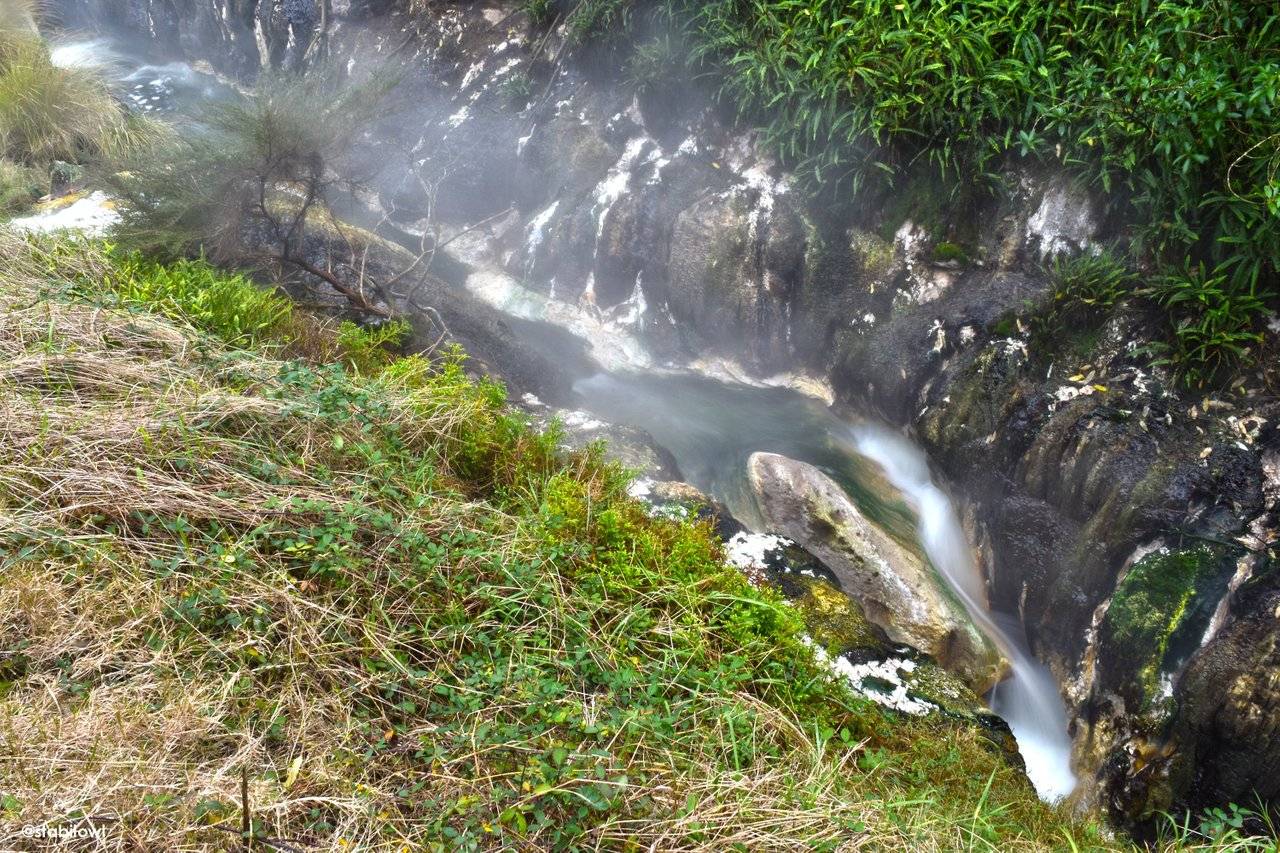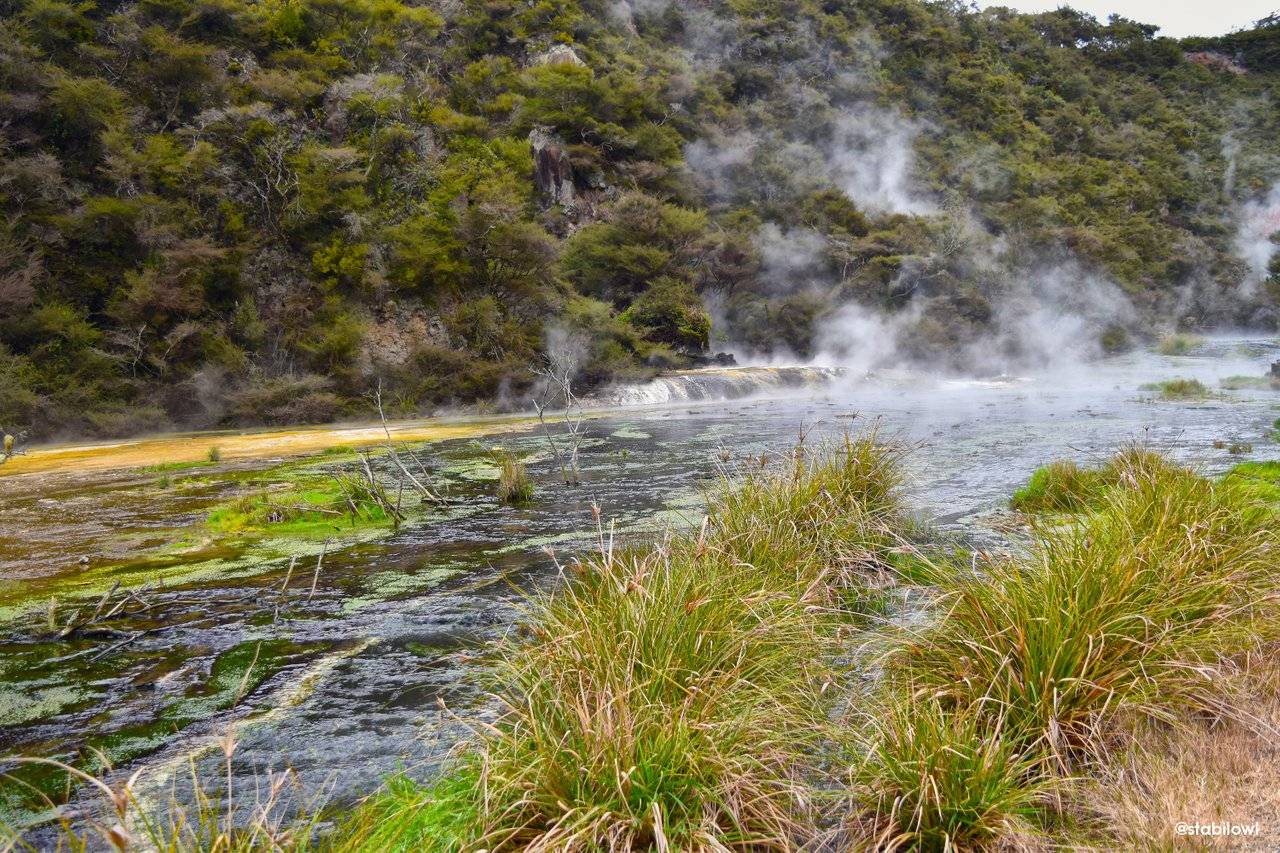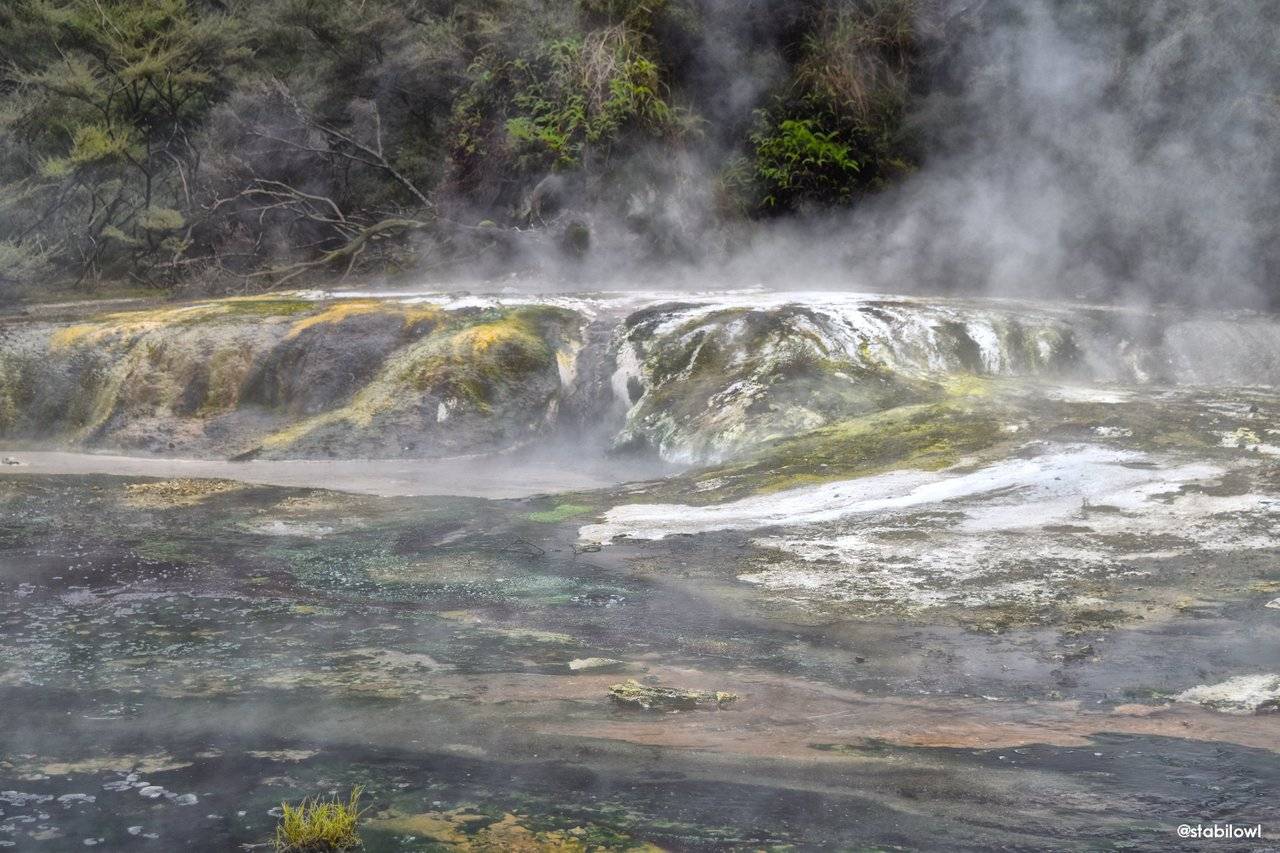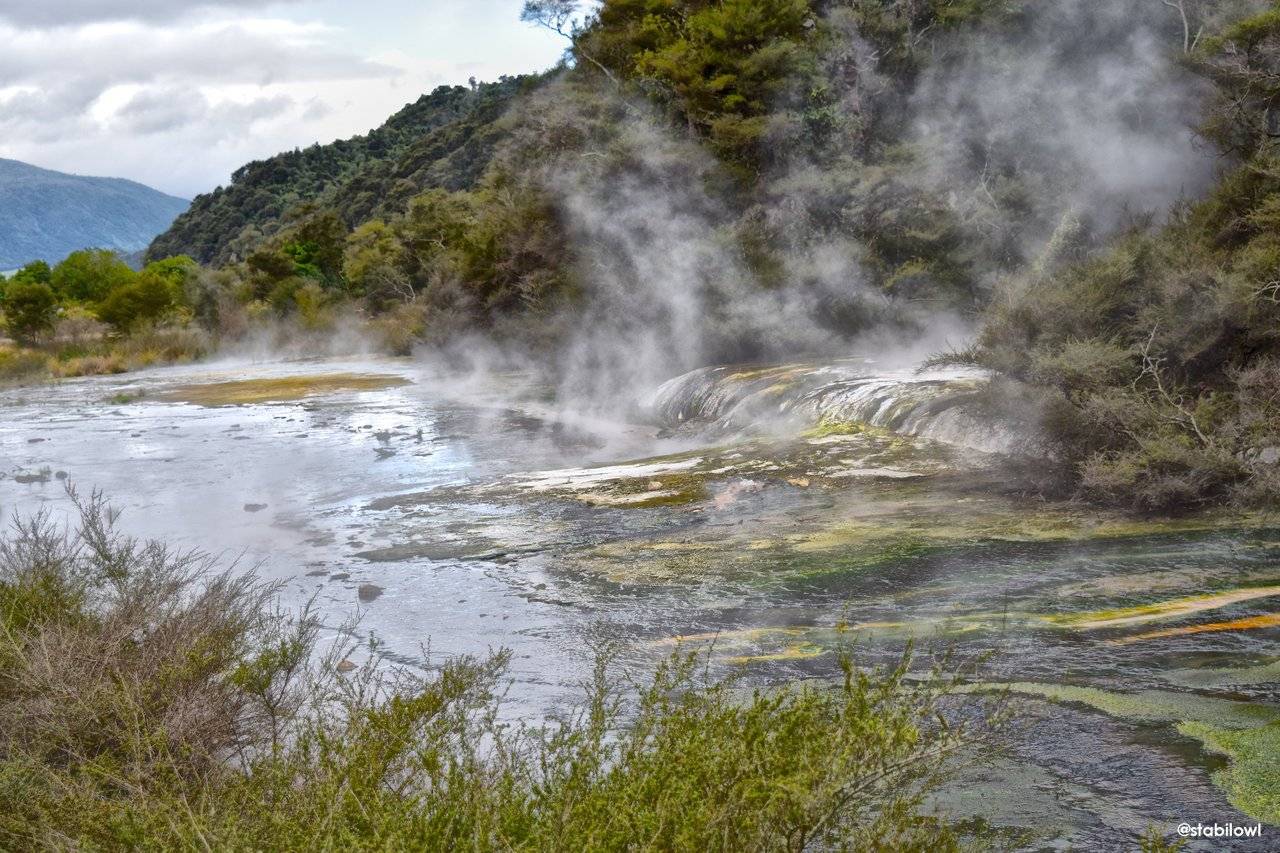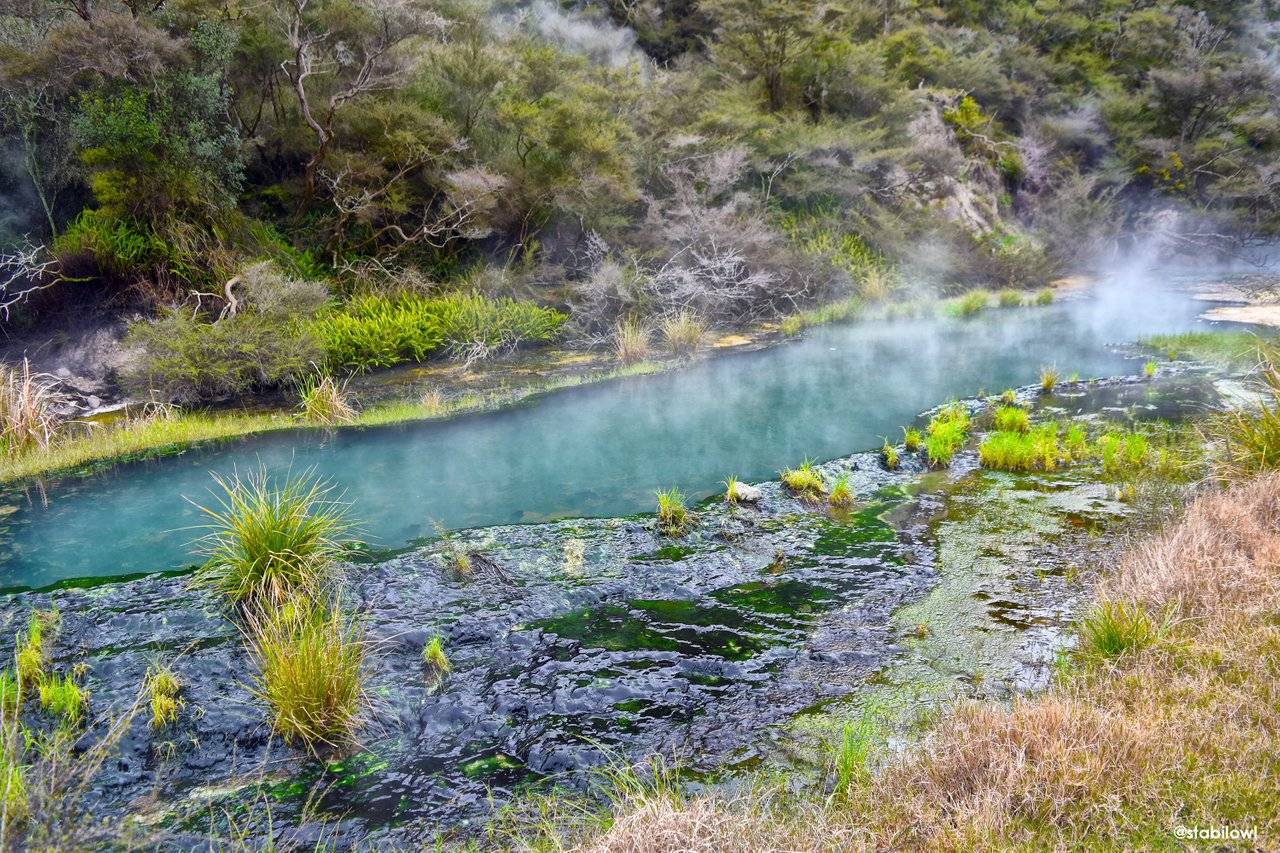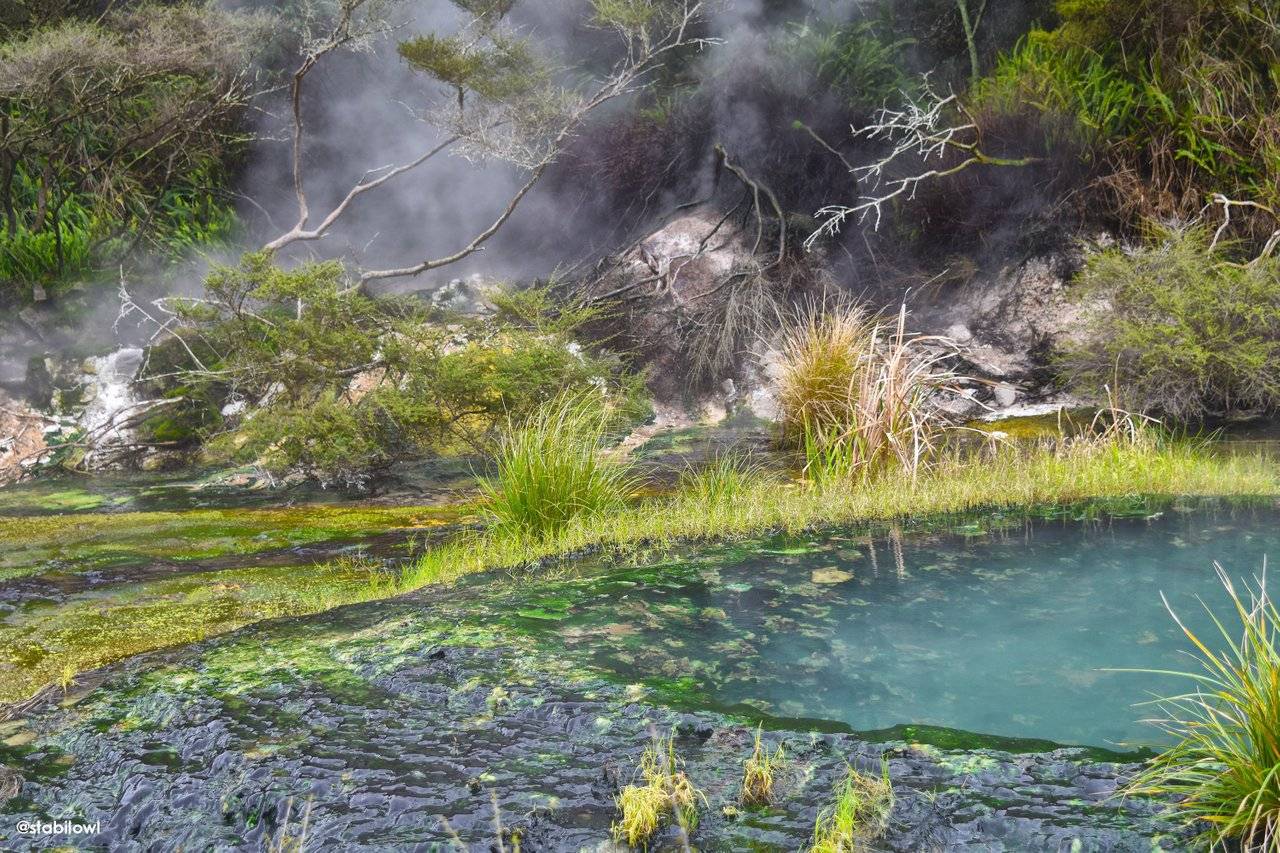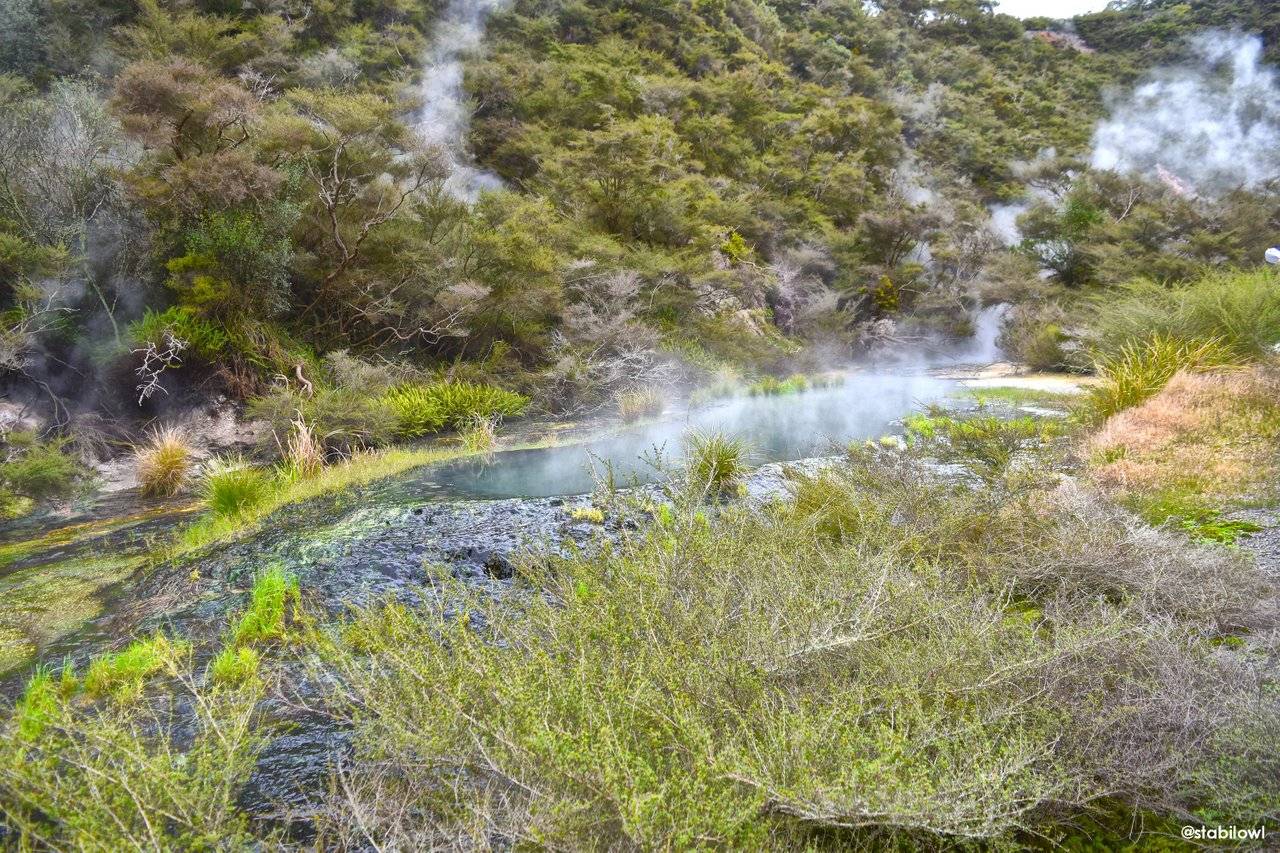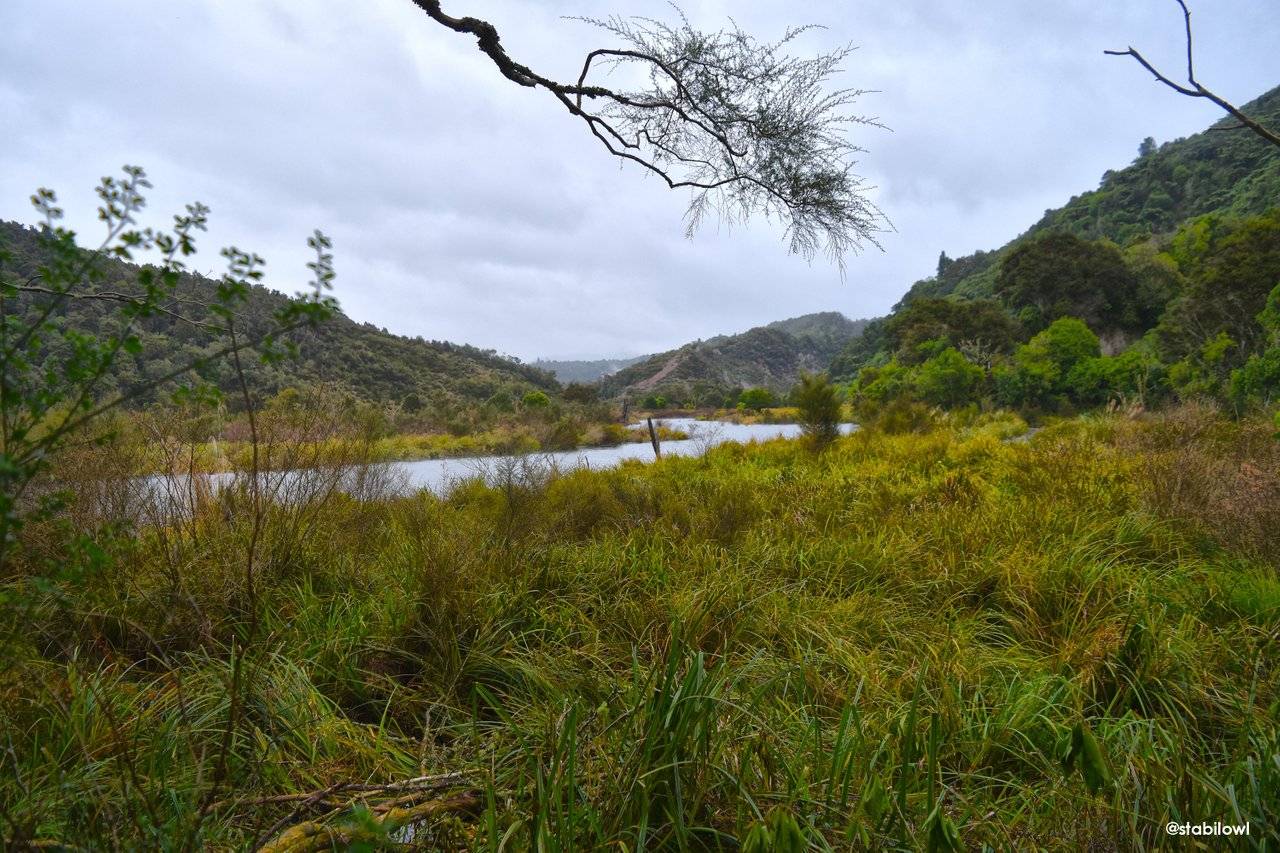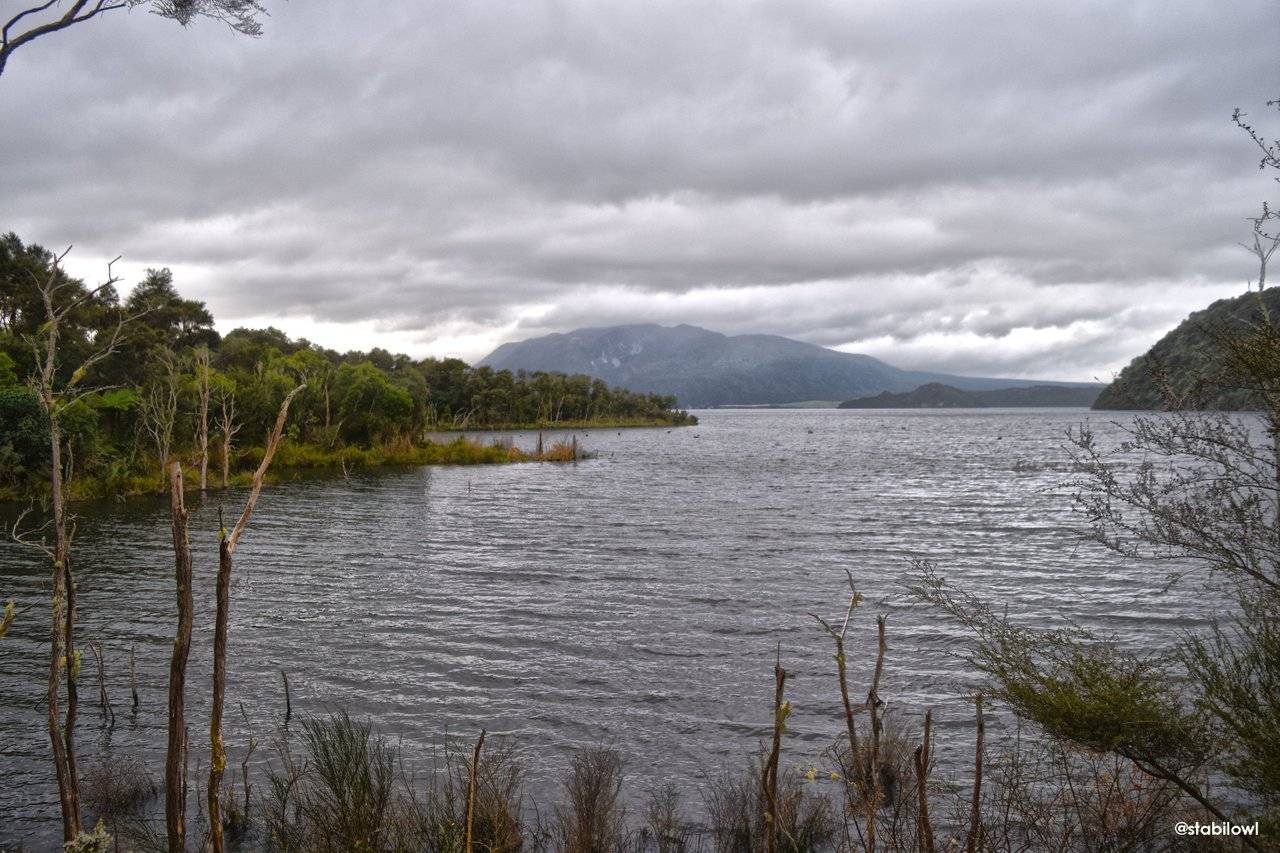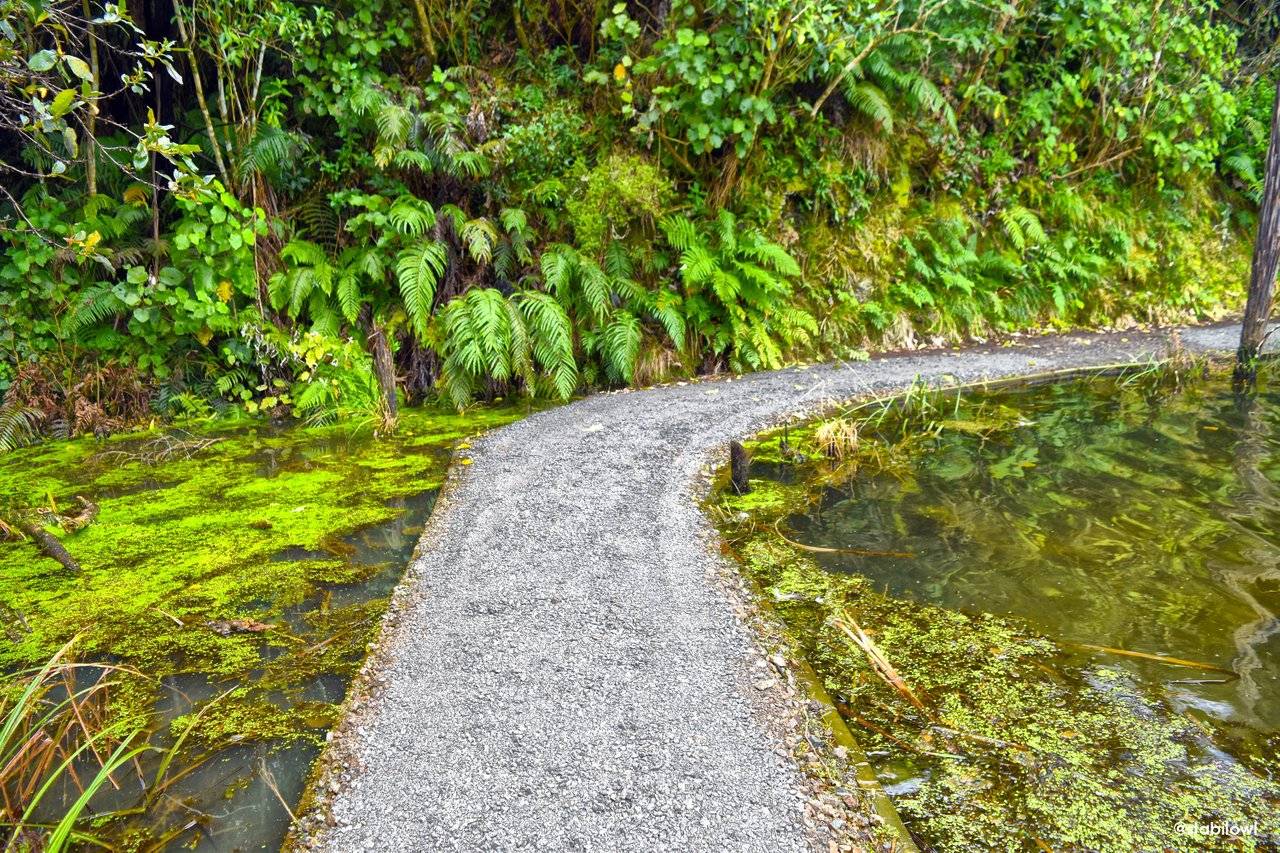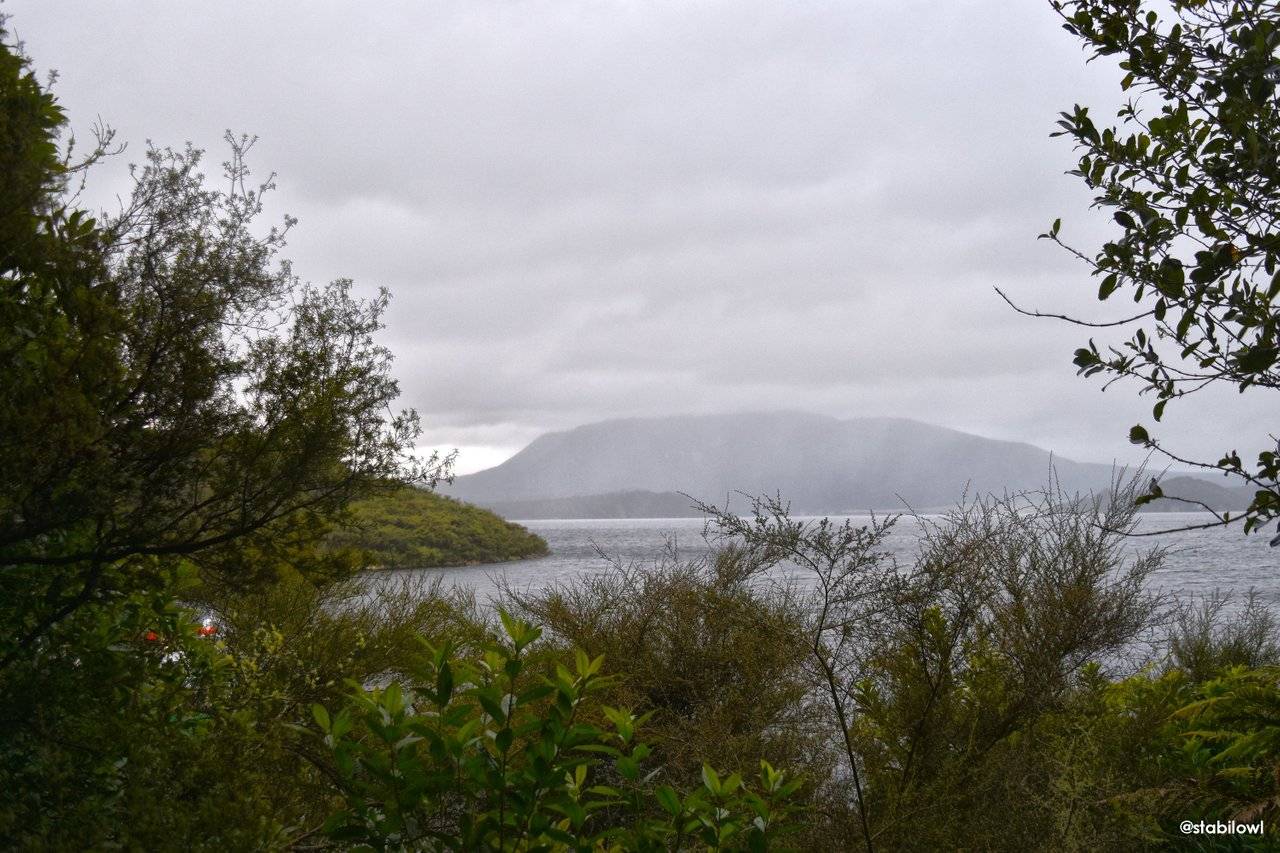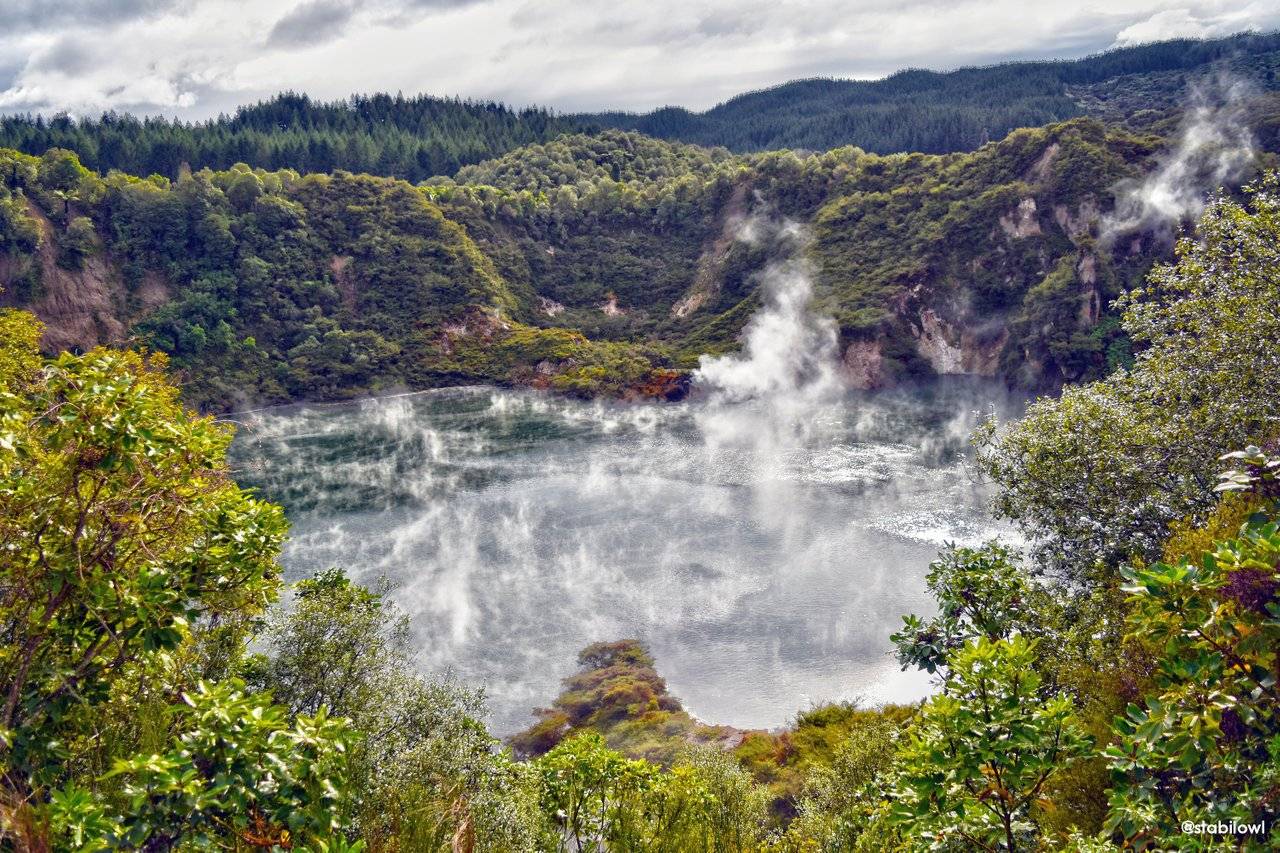
Apart from the Waiotapu thermal wonderland, there are quite a few other places within the Rotorua Region where you can admire geothermal features created by Mother Earth. After all, being an active Volcanic Zone, hot spring, geysers and dormant volcanoes are just some of the common features that can be readily seen in New Zealand’s Central North Island. And one of these places is the Waimangu Volcanic Valley, one of the youngest and most active geothermal areas in the region. The Waimangu Volcanic Valley is also about 30 minutes drive from suburban Rotorua, by the shores of Lake Tarawera. And on this cold winter day, we were lucky to see a little bit of sun after a whole night of pouring rain. We took some umbrellas as a pre-caution nonetheless, and set off to this fascinating volcanic valley.
除了怀奥塔普地热奇景外,罗托努阿周边还有很多地方可以看到地热风貌自然奇观。毕竟新西兰北岛中央是个大型火山区,温泉,喷泉,睡火山等都很常见。而其中一个比较活跃和年轻的地热区就是怀芒古火山谷。怀芒古火山谷大概离罗托努阿三十分钟的车程,位于罗托玛哈纳湖畔。这天早上虽然寒冷,可是下了一整晩大雨后竟然露出了一丝阳光。不过我们还是带上了雨伞,才往火山谷出发。
The Waimangu Volcanic Valley was created in 1886 by a massive volcanic eruption of the nearby Mt Tarawera, which destroyed the Pink and White Terraces, a massive set of Silica Terraces with hydrothermal pools that was a popular tourist attractions for the Pakeha (European People) and was nicknamed the 8th Wonder of the world. These terraces now sits at the bottom of Lake Rotomahana, a geothermal lake created by the eruption. The eruption also killed 150 people and buried a number of Maori settlements. But with such a dark creation came light, as the region slowly repopulated and the newly formed geothermal feature once again became popular attractions. But even after all these years, Waimangu Volcanic Valley is still relatively unspoiled, and much less commercialised compared to Waiotapu. We could feel that already as soon as we drove into the car park. There were no bus loads of tourists, not as many car, everything is just quieter. This suited us well: I would rather go somewhere that is off the beaten track. The information centre was also more humble. We submitted our online tickets to the counter, and were each given a map of the valley. After that, we head out to the entrance to the park, ready to explore.
怀芒古火山谷是在1886年塔拉韦拉火山大爆发时形成。这次火山爆发死亡人数达150,大多数为住在周边的毛里人,随着村庄一起被岩浆流石活埋。这次火山爆发也毁灭了被称为世界八大奇景粉白台阶。粉白台阶是两座硅石台阶,台阶和台阶上的温泉是当时新西兰最著名的景点。可惜因为这次火山爆发永埋罗托玛哈纳湖底。而罗托玛哈纳湖本身也是因这次爆发而成。虽然经历了这么黑暗和暴力的诞生,怀芒古火山谷渐渐的浴火重生,生态慢慢的恢复,而新形成的地热地貌也成了新的景点。然而,与怀奥塔普不同的是,怀芒古由始至终也没有变得商业化,仍然高度保持着原生态的风光。这一特点从进出怀芒古的停车场就可以感受到。在这里看不到大型观光车载着一车车的游客,也看不见太多的其他车辆停泊。这可谓正合我意:没有喧闹的人群,只有自然的风光。火山谷入口的游客中心也比较安静朴实。我们把网上定购的门票递了给售票员,换取了几份火山谷的路线图,然后就走进了火山谷准备探索。
A big difference between Waimangu Valley and Waiotapu is the size and nature of the geological features. Waiotapu is more about many small-scale flats and pools with colourful mineral deposits concentrated within a barren, rocky landscape. Waimangu Volcanic Valley, on the other end, features large scale crater lakes and roaring thermal rivers, set in a deep rift valley with rugged peaks and densely covered native forest. This difference setting apart the two attraction is immediately apparent as we started our walking trail, which leads us from the top of the valley to the lakefront. The path is essentially a bush-walking trail on a hillside, with native ferns growing on the side of the path, and opening in the forest here and there offers a great vista of the valley below. Smoke can be seen in the distance, emitting off from the different geothermal features in the area. The first that we encountered was the Southern Crater, a crater that was initially formed by an eruption occurring here, and is now no longer active. The lake in the Crater is called the Emerald Lake and is a cold lake that is filled with mostly rainwater.
怀芒古和怀奥塔普的最大区别是地热景观的大小和种类。怀奥塔普的地热景观大多是被荒芜的火山岩围绕着的温泉池和地热滩,以色彩斑斓而数量繁多为卖点。而怀芒古的地热景观则是更为气派的大型火山湖和温泉河流,坐落于森林遍布,崎岖不平的深谷中。这两者的区别在一进入景区内就十分明显,因为景区内的行人路线基本上就是一条登山径,穿过原生森林通往峡谷底部,山径的两旁都是新西兰特有的蕨。山边的树林偶尔会有个缺口,让我们看见深谷里的景色。袅袅青烟从山谷的远处升起,标志着不同地热景观的位置。而我们经过的第一个景观就是南坑,一个于1886年的火山爆发中形成的火山坑。这个死火山坑以经没有地热,而火山坑里的翡翠火山湖也只是一潭冰冷的雨水。
Walking past the not too remarkable Southern Crater and continuing on the walking trail, we shortly from an opening in the forest caught a glimpse of the Echo crater, the largest crater in the Waimangu Valley, and the steaming Frying Pan Lake that fills up the bottom of the crater. The Frying Pan Lake is the main attraction in the Waimangu Volcanic Valley. It is the largest hot springs in the world, and the area is still very geothermally active. Unlike the Frying Pan Flat in Waiotapu which was named after its shape, the Frying Pan Lake was named from the fact that you can hear loud hissing sounds originating from the water being heated up along the shore by hot rocks, similar to the sizzling sound you hear when frying something in a pan. We first took a detour going uphill away from the walking track to get to a viewpoint at the top of the hill where we got an overview of the lake. It was a magnificent view to see! Steam from hot rocks along the shore floated along the surface of the lake, forming a web-like veil that lingered on. It was extremely mesmerizing to watch steam and mist being swayed by the breeze, gliding lazily across the lake before rising back up in a wisp. As the sun ducked in and out of the clouds above, the scenery changed from one that was gloomy to one that was delightful, and the shades of the lake changed slightly as the sun's reflection gave a slightly golden glow. Across the lake, irregular peaks covered with flora was shrouded in clouds of white mist, so mystic looking that you would half expect a dragon flying out from the top of one of those rocks. These are the cathedral rocks, probably named after its shape.
离开了那不甚特别的南坑和翡翠湖我们继续沿着山路往下走,过了不久就看见了怀芒古山谷中最大的火山坑,回音坑,和火山坑里的冒着烟的火山湖,煎锅湖。煎锅湖是怀芒古谷里的著名景点,而且是全球最大的温泉。不同于怀奥塔普里因像煎锅而名的煎锅滩,煎锅湖的名字起源于湖水因湖边的热石头而受热所发出的巨大的嗞嗞声,像极一个在烧菜的煎锅。我们先从行人径绕行,到达山顶上的瞭望处。在这里可以高高在上的饱览着这个火山湖的迷人风景。热腾腾的蒸汽从湖边的石头喷出,化作一丝丝的白雾在平静如镜的湖面上飘过,像蛛网一样在湖面上纵横交错。看着这丝丝白雾在微风中摇曳,懒洋洋的飘浮着,最后化作青烟袅袅,真是为之着迷。太阳从云层中闪躲着,烈日的金光也随着云朵的节奏把风景从沉沉的灰绿变成活泼的金黄。在湖对面,陡峭的奇峰被绿树和白雾所覆盖,烟雾弥漫犹如仙都秘境。这些奇峰名为教堂石,因其形似教堂的尖顶而得名。
Following the main track, we took in more of the beauty of the Frying Pan Lake as we made our way slowly downhill. Along the way, we saw a more panoramic view of the lake. It was indeed very big, much bigger than any features that we have see at Waiotapu from the previous day. From here, we could also see more clearly the thermal activities on the shoreline of the lake. Clouds of steam bellowed from various vents and hot rocks; water bubbling in the middle of the lake as if it was boiling; and various colourful, smoking terraces dotting along the shore. The Echo Crater is in fact one of the more active areas in the Rotorua region, with major eruptions observed here as late as 1970s.
我们沿着山路下山,一路上看到更多煎锅湖的景色。其中在山腰有个观景点,让人可以欣赏煎锅湖的全貌。在这里,我们可以感受到煎锅湖的庞大,比怀奥塔普的任何一个景点都要大。我们还可以更清楚的看见湖边活跃的地热活动: 像云雾一样的蒸汽从岸边的石头和气孔涌出,水泡从湖中冒出犹如沸水,还有岸上散落着冒着热气的五彩台阶。其实回音坑这一带是罗托努阿附近最活跃的火山区,上一次爆发是在1970年左右。
Eventually, we reached the bottom of the crater. Along the lakefront, we could see steam gushing out everywhere, covering the landscape with a dense fog like morning mist often seen on a typical lake on a cold morning, except here, it is an all-day-affair. We could also see clearly where the lakes bubbled, and it was clear that the bubbling was from a gas vent underneath rather than the from the lake water boiling. We could also see the cathedral rock close up from here, and we could see clearly where the smoke that covered the rocks originated from.
好不容易终于到了谷底。在这个低角度,我们看见湖面上蒸汽弥漫,就像常见于冬天早上湖或河面上的晨雾。只是在这里,这种烟雾是全天候的景像。从湖边看,湖中的水泡很明显不是因为沸腾而引起,而是因为水底的气孔喷出的火山气体所形成。从底下往上看,教堂石的确是很雄伟。在这个角度可以清楚看见白烟是从哪几块石头冒出。
From the bottom of the crater, we continued on the walking track which followed the Waimangu thermal stream, an overflow stream from the Frying Pan Lake. While it is called a stream, the volume and flow seemed to be much stronger compared to the streams we have seen at Waiotapu, and at times the steamy mist from the heat of the river pretty much blocked most of the visibility. Streaks of green, yellow, orange and black could be seen along the stream and in the stream-bed, originated from a combination of mineral deposits and colonies of special algae and bacteria that is adapted to the high temperature of the thermal water. There were places along the stream that was obviously reaching boiling temperature, and you could hear loud bubbling noise behind scrubs along the stream. It is therefore essential that visitors stay on the walking track.
从回音坑的低部,行人径穿过一条泥泞车道,在路的另一边沿着从煎锅湖流出的地热河继续伸延。这条地热河的流量比怀奥塔普的地热溪要大得多。水的温度也比较高,有时候蒸汽多得我们伸手不见五指。河边和河床里充斥着黄、绿、橙和黑的条纹。这些条纹源自地热矿物的沉淀和一些能够在严酷环境生存的抗热藻类和细菌群。有些地方河水达到100度,在路旁可以听见丛林后方沸水在噼噼啪啪的响。因此游客千万不能离开行人径,不然会有可能掉进沸水里。
Eventually we came to a cross road marked by a little mount that looked like an anthill squirting out sprays of hot water. This is the bird nest spring and it was quite a sight to see. The terraces formed from this spring water spreaded quite far of a distance, and it was densely covered with green algae and orange bacteria, as the slightly cooler conditions around the spring was more favourable for them compared to the constantly running thermal stream. As the water spray got caught in the wind, it mixed with the light veil of steam coming from the vent, resulting in a very picturesque scene.
半路上有个分叉路口,分叉口的旁边有个非常有特色长得像蚁穴的喷泉。这喷泉叫做鸟巢泉。鸟巢泉的泉水矿物丰富,所以因泉水而形成的台阶可以扩展得很远。台阶上的温度比较低,大量的藻类和细菌可以在台阶上滋生,台阶上的色彩也因此看上去比周边饱和。喷泉口喷出来的泉水随风往四方散落,和四周的白雾相映成趣,美妙如画。
From here, we took the detour uphill, walked up a flight of stairs and reached the Inferno Crater. This most colourful feature of the whole of Waimangu Valley, for the lake water here is a clear turquoise blue. While it might be tempting to take a refreshing bath in such beautiful and warm water, the water here is actually very acidic, almost as acidic as the stomach acid in your stomach. It is also the largest geyser in the world! Except the geyser is actually at the bottom of the 30 m deep lake so you can’t quite see it. But all these didn’t stop the Inferno Crater being magnificently beautiful, with the crystal-like water reflecting off the cliff-face of the crater, and smoke and mist flowing across the lake surface, accompanied by the hissing sound of the fumaroles spraying water and hot gases on the other side of the lake.
分叉口有楼梯上山。登山楼梯的尽头是全山谷颜色最鲜艳的景点:地狱火山湖。地狱火山湖颜色蔚蓝清澈,像蓝宝石一般。然而看上去这么漂亮的瑶池仙境,池水竟然是能腐筋蚀骨的强酸!所以千万不能跳进去游泳。地狱火山湖还是全世界最大的地热喷泉,只可惜这个喷泉位于湖底30米的深处,我们没办法看到。不过这里的风景还真是漂亮:宝石般晶莹剔透的湖面,倒影着湖边的峭壁;白茫茫的蒸汽飘浮在湖上,衬托着浅蓝的湖水。配上湖边小气孔喷水发出的轻吟,真是让人叹为观止。
From the inferno crater we backtracked to the Bird Nest Spring, and then continued to follow the thermal stream. The stream became wider as we continued on, and eventually became a sizeable waterfall that plunged downhill. This was also where the track routes back to the unsealed road, and we had to stop here to wait for the shuttle. On normal days, visitors can continue to follow the thermal stream downhill, but on this day, the heavy rain from previous days meant that the track became too dangerous to walk, and we could only get to the next waypoint by shuttle bus. The shuttle buses were scheduled to come every 30 minutes. Luckily we didn't have to wait too long. Within 10 minutes we were on board of an old shuttle bus on our way downhill towards the beginning of the next track.
从地狱火山湖回到鸟巢泉,我们继续沿着地热河前进。地热河的水流渐渐变急,河床变宽,最后变成的滚滚瀑布,急流而下。瀑布的开始正是山径的终结,行人径接回去泥泞车道上。通常游客可以沿着车道下山到达下一段山径。然而因为近期的暴雨,山径变得危险,所以他们把山径封了。游客只能在这里乘坐免费的小巴下山。小巴通常每三十分钟一班,不过很幸运,我们只等了十分钟汽车就来了。
The bus could take us directly to the end of the whole track at the lakefront, but we hopped off at the next stop, wanting to make the journey ourselves. This No. 2 bus stop was a toilet stop for all, as there were no toilets at the Lakefront, but it was also where the Warbick Terrace is located. This terrace is active and very fast growing, and used to have a geyser on top. Now there is no geyser, but the terrace and the pools on top of it is still steaming like mad, and orange and green decorated the terrace with colour. Next to the terrace was an enclosed pool known as the blue pool. The pale blue colour came from the rich silica level in the water. Apparently the pool sometimes drain empty and reveals the interesting silica deposit at the bottom of the pool. There were some picnic tables in the area, and the tranquillity would indeed make this place a great place for a picnic lunch. However, it looked like it was starting to rain, and more importantly, we didn't actually have any food on us. So we continued on.
乘坐这免费小巴可以直达罗托玛哈纳湖畔,不过我们还是想再走一段路,所以选择了在二号小巴站下车。二号小巴站可以算是个中途休息站,有厕所还有野餐桌。不过最吸引的还是这里的沃比克台阶。沃比克台阶是怀芒古山谷里生长得最快的硅石台阶,是个地热非常活跃的地点,以前在台阶顶上还有个喷泉。现在喷泉已不知所终,可是台阶依然蒸汽不断,台阶上遍布绿色的青苔和橙色的菌群。沃比克台阶旁边有个蓝色的池子,池水的蓝色源于水里高浓度的硅化物。这个池子有时候会干涸,露出池底不同形状的氧化硅沉积物。这里的漂亮景色的确适合一边野餐一边欣赏。只可惜开始下雨了,更重要的是我们也没有带吃的。我们只好继续往前。
From here onwards, we continued to follow the thermal stream, which was no longer thermal as it was no longer running on hot rocks, and was at this point more like a river. So we followed the river, walking through a swampy landscape. The river became wider and wider as it flowed into Lake Rotomahana, and we started to see water birds such as swans swimming beside the river bays, and water plants such as reed replacing the native forests beside the walking track. Eventually we got a glimpse of Mt Tarawera, standing tall on the opposite side of the lake, it's wide chasm on the summit like a scar on its face, marking the violent event that shaped the Waimangu Valley. By the time we got to the Lakefront, it was pouring down, and being wet, cold and hungry, we decided to skip the boat ride and headed back up to the valley entrance.
从这里我们继续沿着河前进。然而河已经因为离开地热带变得没有温度,而水流也从秀丽细水变成宽敞的大河。行人径随着河流带我们穿过一片洼地,也让我们看到了比地热区更丰富的生态系统,例如水鸟、芦苇和其他动植物群。我们也看到了湖对面的塔拉韦拉火山,火山上粗大的裂口就像它脸上的一道疤痕,提醒着人们那次造就了怀芒古谷的毁灭性灾难。当我们到达罗托玛哈纳湖畔码头,行人径的尽头,塔拉韦拉火山早就躲在乌云后,天也下起雨了。在码头有船可以带游客游览罗托玛哈纳湖中的地热景点,不过在这么恶劣的天气下,能见度肯定很低。所以我们最后决定不上船,还是坐小巴回去入口,结束了我们火山谷之旅。

Ready to Blog & Earn?
With TravelFeed, easily start your own travel blog and earn as you go. It's the smart platform for travelers who want to profit from their passion. Create a free account
As we drove back to Rotorua under the heavy storm, we felt lucky that we managed to get through the Waimangu Valley without getting too wet. And it was a good decision to go to the Waimangu Volcanic Valley, as even though it was one of the many geothermal attractions in Rotorua, it was so different in nature to the Waiotapu thermal park that we visited the previous day. After bush walking in the Waimangu Valley, we felt relaxed, refreshed, and connected with nature. It was well worth our time. So if you have a few days to spared in the Rotorua region, we would definitely recommend going to Waimangu Volcanic Valley to experience a different side of Rotorua.
Don't Forget: Get Travel Health Insurance!
To make your trip a worry-free experience, TravelFeed recommends SafetyWing Nomad Insurance. It provides comprehensive health coverage while you travel, so you can focus on exploring, not the unexpected. Get a quote here
回去罗托努阿的路上,天空下起了滂沱大雨,让我们为可以在被淋湿前完成了怀芒古火山谷之旅感到庆幸。我们也对这个景点很满意。虽然网上很多人提议在同为地热景观的怀奥塔普和怀芒古中二选一,但是实际上这两个景点非常不一样,景色各有千秋。在怀芒古火山谷走了一天,回归大自然的感觉非常棒,让整个人都放松了。所以如果到罗托努阿玩,记得留点时间去怀芒古火山谷看看,非常值得哦!
Posted from my blog with SteemPress : http://stabilowl.vornix.blog/2018/08/14/travelling-with-stabilo-27-waimangu-volcanic-valley-%e7%bb%8f%e7%ba%ac%e6%b8%b8%e8%b8%aa-27-%e6%80%80%e8%8a%92%e5%8f%a4%e7%81%ab%e5%b1%b1%e8%b0%b7%e5%9c%b0%e7%83%ad%e5%8c%ba/
Travel Resources for your trip to New Zealand
Recommended by TravelFeed
Flights: We recommend checking Kiwi.com to find the best and cheapest flights to New Zealand.
Accomodation: Explore the best places to stay in New Zealand on Booking.com, Agoda and Hostelworld.
Travel Insurance: Medical emergencies abroad can be pricey, but travel health insurance is not. We always use SafetyWing for affordable and reliable coverage.
Car Rental: For hassle-free car hiring, DiscoverCars is our trusted choice with a wide selection of vehicles.
Internet: Got an eSIM compatible phone? Airalo is perfect for reliable internet access during your trip. Just install it before you go, and you're set!
Day Trips & Tours: We recommend GetYourGuide for a variety of well-organized and enjoyable activities.
Travel Planner: Need a hand planning? Our free travel planner chatbot is your personal guide to New Zealand. Chat now.
Disclosure: Posts on TravelFeed may contain affiliate links. See affiliate disclosure.
